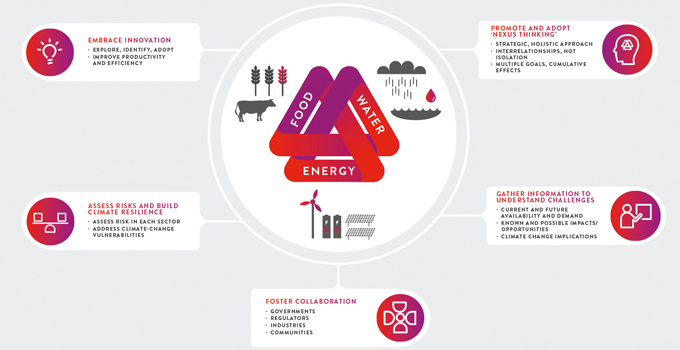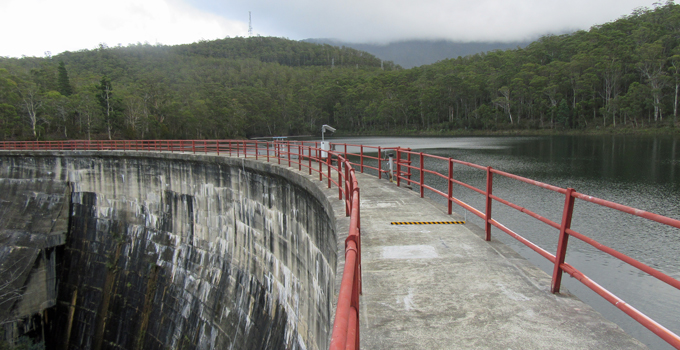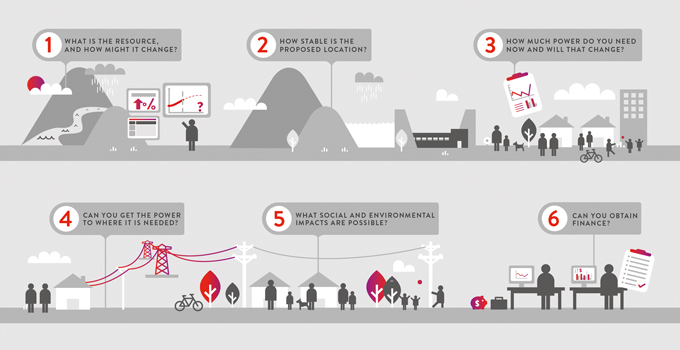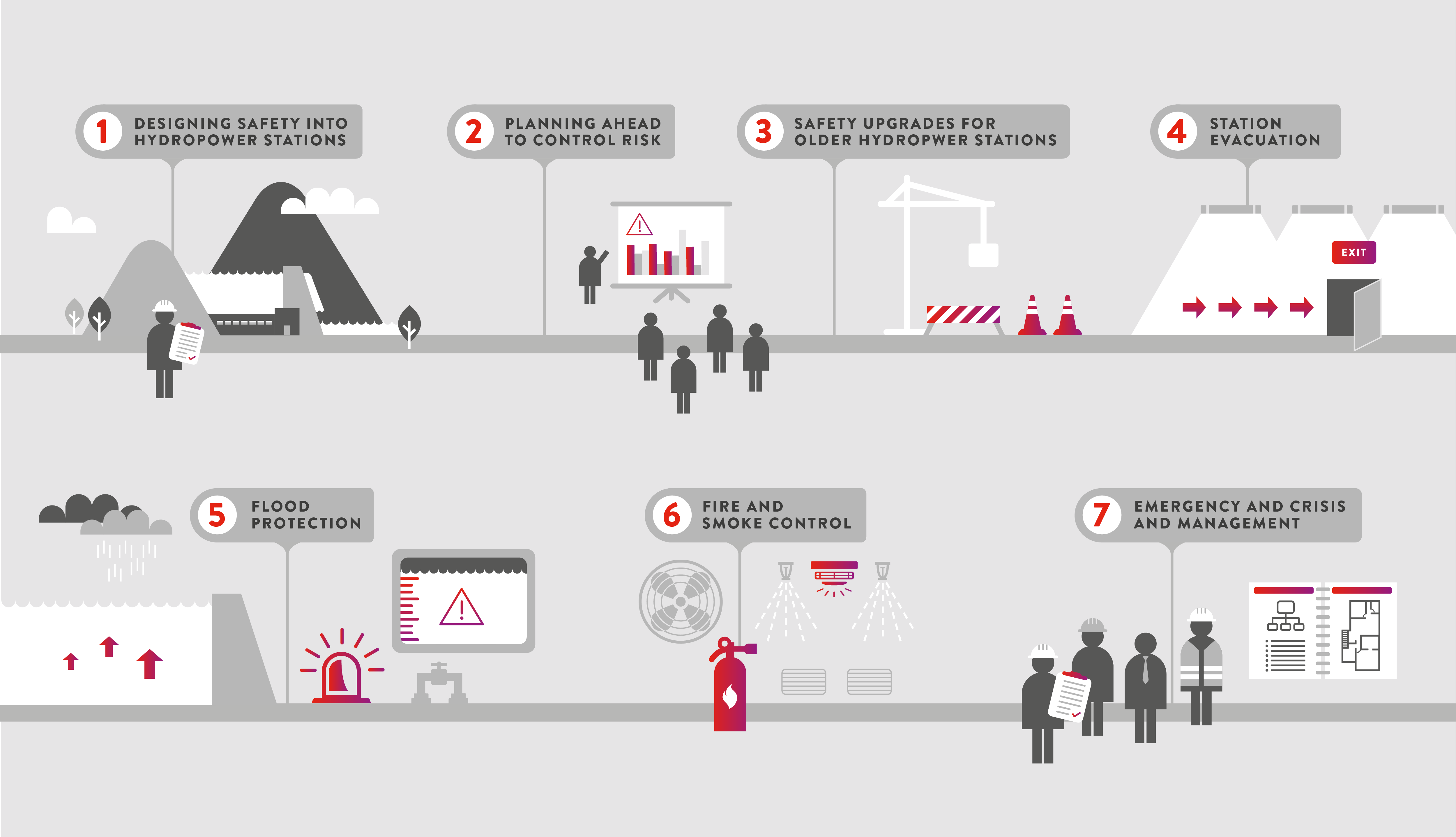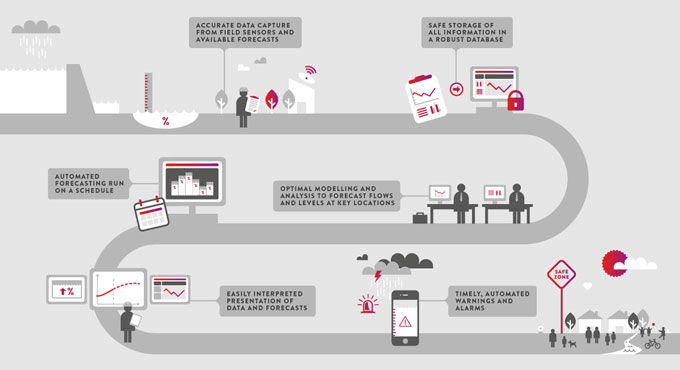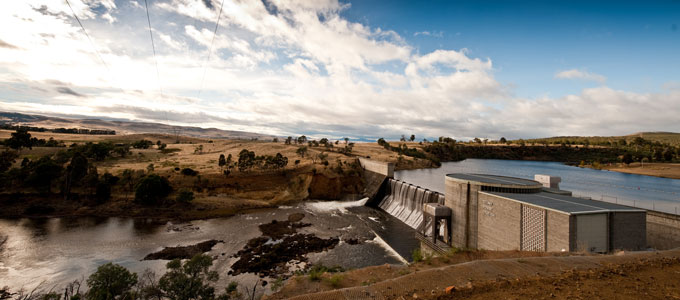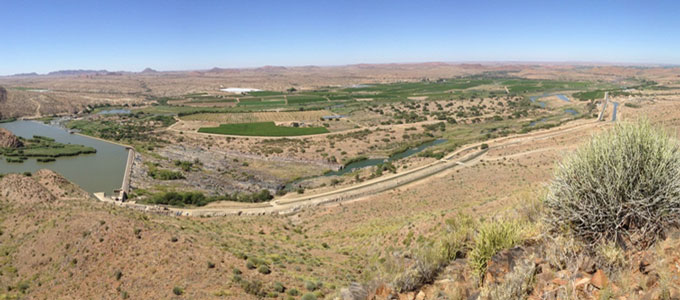‘Nexus thinking’ for a secure and sustainable future
As the global population continues to grow, how can utilities and water managers balance the increasing and interrelated pressures on water, energy and food?
The complex triangular relationship among these three pillars of life is known as the ‘water-energy-food nexus’. It’s an intricate puzzle, in which the increased demand for each limited resource can significantly affect the security of all three.

According to the International Renewable Energy Agency, over the next few decades, global growth in population, economic development and urbanisation are expected to raise demands for water and food by 50% and to double the demand for energy. Water, energy and food are all fundamental to growing economies, alleviating poverty, and improving health and educational opportunities worldwide. To create a sustainable future, we must seek holistic and integrated solutions for water, energy and food challenges , as well as the appropriate balances amongst them.
With water being so central to food security and energy security, the potential impacts of climate change on water resources are of increasing concern. Climate change is likely to raise average temperatures in many locations, change the patterns of rainfall and inflows, and affect the frequency and severity of extreme weather events such as drought or floods – all of which increase vulnerabilities for water, food and energy resources already under strain.
A nexus approach
Our experiences throughout Australia and the Asia-Pacific region demonstrate that there is no single solution to the challenges of this nexus. It is really about a way of thinking and approaching decisions rather than a fixed solution or response.
These five broad considerations are likely to contribute to improved nexus outcomes.
Promoting and adopting ‘nexus thinking’
‘Nexus thinking’ means considering and understanding water, food and energy and their interrelationships, rather than viewing any in isolation. It is a strategic and holistic style of thinking that considers long-term implications across the nexus, weighing up and balancing social, economic and environmental goals.
Nexus thinking looks at the big picture: considering the whole catchment or river basin, trans-boundary issues, multiple uses (existing and future) and cumulative effects. It also involves thinking across agencies and organisations where responsibilities for water, food and energy lie.
Gathering the best information to understand nexus challenges
Responses to nexus challenges are more likely to be effective and sustainable if they are based on an informed and risk-based understanding of present conditions and possible future scenarios (taking into account interrelationships across sectors and regions).

This means that decision-makers need to understand the resource availability, current demand, known impacts, development opportunities and potential climate change implications in a given situation. They also need to understand what stakeholders and communities need, and explore opportunities for additional benefits to be realised.
Fostering collaboration among government, regulators, industry and communities
All stakeholders can benefit from collaborative and cooperative responses to the nexus and to stewardship of resources. The potential wins include better economic outcomes, improved reputation, reduced risks, avoided conflict, and opportunities for greater synergies. Reaping the benefits will require partnerships and cooperation among food-producing industries, the energy sector and other water-dependent industries, as well as local communities.
It’s also essential that governments, regulators and communities are closely involved in all decisions and developments affecting water, energy and food resources so that different priorities and opportunities can be considered. At a policy and regulatory level, cohesive and stable governance, policy and strategies are needed to facilitate and encourage the right collaboration that brings benefits to all stakeholders.
Assessing risks and building climate resilience
The water-energy-food nexus brings risks as well as opportunities . Interrelationships between water, energy and food, and the threats posed by climate change, should be built into risk assessments in each sector. State-of-the-art data collection, modelling and forecasting can assist businesses, governments and communities to better understand and mitigate their specific climate-related vulnerabilities and take action towards building greater resilience to future climate change impacts.
Innovating
In the water, energy and food sectors, technological and other innovations continue to expand the opportunities for improving productivity and resource efficiency for long-term sustainability of pressured resources.
Nexus challenges may also bring opportunities
The nexus is not only a dynamic of ongoing resource competition. Integrated planning offers opportunities for potential synergies and benefits among sectors.
For example, in the hydropower sector, electricity generation is intrinsically linked with water availability. The need for water for irrigation to produce food and to drive agricultural productivity may compete with water requirements for hydropower generation. Hydropower’s water needs may also compete with the requirements of urban water supply, other industries and environmental and social needs.
However, renewable energy resources such as hydropower can also offer benefits to the water and food sectors through improving water resource management, providing multipurpose storages, contributing to the development of water supply infrastructure and, of course, generating the electricity critical to food-producing industries.
Many existing hydropower storages, both in Australia and internationally, were developed solely to supply water for energy generation. However, over time and with increasing competition for water and food, the storages have become multipurpose, often providing water for domestic supply, irrigation, and commercial and recreational fisheries.
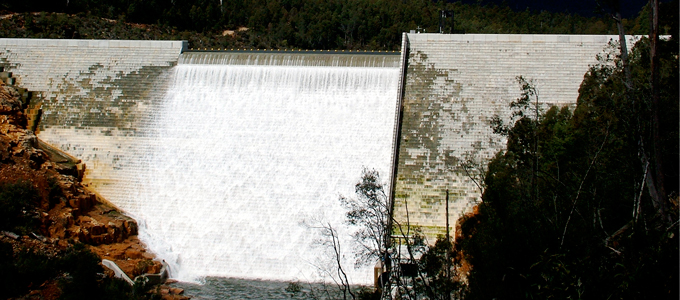
In South-East Asia, some hydropower storages are now more important as a source of irrigation water for downstream communities than for the energy they generate. By providing water to the downstream communities, irrigation and food production has increased significantly since development of the schemes, lifting the economic development of the region and providing benefits across the community.
Integrating other renewable energies into water supply, irrigation and food production can also provide mutual benefits, such as utilising renewable energy for pumping on farms or for water desalination. Incorporating small hydropower into existing water infrastructure can improve efficiencies and create new low-carbon income streams to support effective water supply delivery. Another innovation of attaching solar PV to covers on water storages provides electricity for pumping while minimising evaporation and maximising water availability.
Whether at small-scale single utility or local geographic area or at a national or multinational scale, nexus thinking can bring about mutual benefits for energy, water and food outcomes .
If you would like to find out more about how Entura can help you develop a sustainable water or energy solution or respond to the challenges of the water-energy-food nexus, contact Dr Eleni Taylor-Wood on +61 3 6245 4582.
About the authors
Dr Eleni Taylor-Wood is Entura’s Principal Consultant, Environmental and Social Science. Eleni has more than 20 years’ experience successfully managing large-scale, complex projects that run over several years, as well as providing expert advice and independent review for a range of infrastructure and planning projects. She has worked on projects around the world including in Australia, Mozambique, South Africa, Iceland, Colombia, India, Malaysia, Mekong, Solomon Islands, Fiji and Papua New Guinea. Her experience covers a vast gamut of studies including: environmental and social impact assessment and management; strategic management of wetlands and waterway; feasibility and approvals for new hydropower projects, environmental flow determination and assessment, and sustainability assessments. Eleni is currently one of eleven Accredited Assessors under the Hydropower Sustainability Assessment Protocol worldwide.
MORE THOUGHT LEADERSHIP ARTICLES
Batteries vs pumped hydro – are they sustainable?
A sustainable grid needs sustainable energy sources. While there’s no doubt that it makes sense to store renewable energy, whether in batteries or in a pumped hydro scheme, just how sustainable are these technologies?
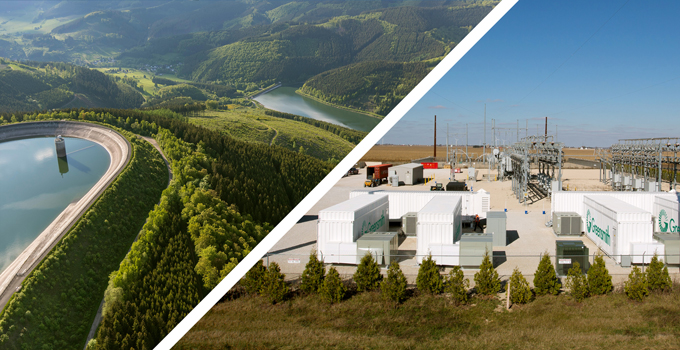
As we move rapidly towards ever-greater levels of wind and solar power in the network, increasing quantities of storage are needed to smooth intermittency and ensure secure supply. Pumped hydro energy storage and batteries are likely to do much of the heavy lifting in storing renewable energy and dispatching it when power demand exceeds availability or when the price is right.
We’ve previously compared the two technologies in terms of their costs, the speed with which they can be deployed, and their ability to support the grid. Here we compare their sustainability in terms of storage efficiency and capacity, safety, use of scarce resources, and impacts through all stages of their lifecycle.
Storage efficiency and capacity
For both batteries and pumped hydro, some electricity is lost when charging and discharging the stored energy. The round-trip efficiency of both technologies is usually around 75% to 80%. This level of efficiency for either technology represents a significant displacement of non-renewable generation if we assume that the stored generation would not otherwise occur.
A particular consideration for batteries is degradation. Batteries degrade as they age, which decreases the amount they can store. The expected life of the batteries that will be used for the recently announced battery storage project in South Australia is about 15 years (depending on how the batteries are operated). By the end of that time, the capacity of the batteries is expected to have dropped to less than 70% of their original capacity.
To maintain a reliable and steady capacity for storage as batteries age and degrade, large-scale battery plants will require ongoing staged installation and replacement of batteries. In comparison, the degradation of pumped storage is close to zero. With appropriate maintenance, peak output can be sustained indefinitely.
Safety
No storage solution can be considered sustainable unless it is safe. The greatest risk relating to pumped storage is dam safety. If it occurs, dam failure can affect downstream communities and the environment, with its impact potential likely to be far greater than a battery safety incident. Nevertheless, pumped hydro technology is mature, dam risks are generally well understood and managed, and the frequency of dam safety events is low.
The main safety concern for batteries is thermal runaway leading to explosions and fires. The severity of this risk will depend on how a battery project is implemented. In a modular arrangement, thermal runaway would be localised, not affecting the whole bank. However, because of the very rapid deployment of evolving battery technologies, safety standards may not be rigorously enforced.
Impacts on land and water
Pumped hydro and grid-scale battery plants may have environmental and land-use impacts. These impacts would vary depending on the sensitivity of the site selected.
A grid-scale battery facility needs a relatively small parcel of land and is likely to be able to be created very close to the energy demand or where generation occurs. Land in these areas has often already been disturbed and the new operations may have little extra environmental impact. Land and water impacts of batteries relate more to their disposal at the end of their effective life, and to the extraction of the resources to produce new batteries.
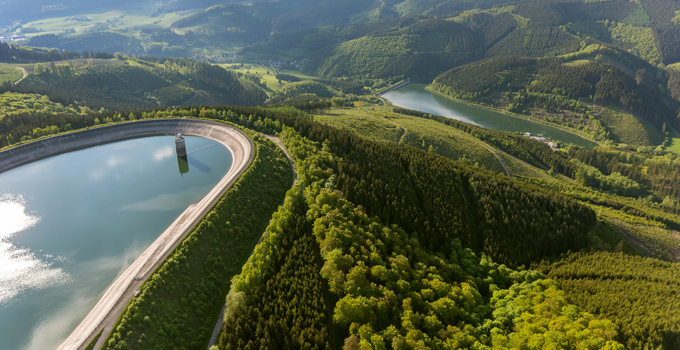
Pumped hydro requires a relatively larger parcel of land with a very particular topography, and may be far from the location of the demand. Any potential environmental impacts associated with construction and operation need to be considered and mitigated, including those immediately associated with the site, as well as downstream.
In most construction of new pumped hydro, sites are selected where impacts can be mitigated to acceptable levels, for example by using existing reservoirs, or locating ‘closed loop’ systems away from rivers. Although these arrangements will have lower overall impacts, some environmental challenges may still occur during construction when existing water is removed from the site as well as finding a source of water without impacting the environment and other users.
Environmental impacts during operation of pumped hydro are minimal. However, the ecology within the reservoirs will need to adapt to frequently changing water levels, reducing diversity in the system especially within fringing communities.
In all pumped hydro systems, water is re-used over and over again, extracting maximum value from the resource. Nevertheless, depending on the configuration of the pumped hydro project, there may be an ongoing demand for water to top up the storages to counter evaporation.
Minerals and materials
Batteries and pumped hydro require a range of different resources and materials. Lithium-ion batteries use common materials such as plastic and steel as well as chemicals and minerals such as lithium, graphite, nickel and cobalt. Although pumped hydro mainly relies on common building materials such as concrete and steel, the quantities of these materials and the construction impacts can be significant.
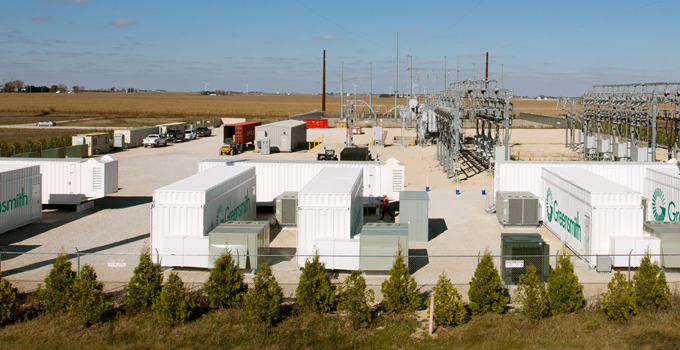
Image courtesy of Greensmith, a Wärtsilä Energy Solutions company.
Determining the ultimate sustainability of the required resources and materials for both technologies needs to take account of the full lifecycle and supply chain (mining, processing, refining and manufacturing) as well as end-of-life issues such as recycling, disposal or decommissioning.
Currently, the environmental and health impacts of mining are a significant sustainability concern for the battery industry, and impacts are likely to intensify as worldwide demand for the necessary minerals rapidly increases. Short-term availability of many of the necessary minerals for battery development, such as lithium, appears sufficient, yet security of supply could be compromised by geo-political factors, and long-term availability will depend on levels of demand.
Ultimately, the minerals used in lithium-ion batteries are finite resources, so limiting or reducing their extraction (for example, through greater recycling or substitution for another battery technology) would increase longer term sustainability.
End of life
A battery’s life depends on the technology and on frequency of charging and discharging. Once their effective life is up, the batteries must be disposed of and replaced. Disposal of batteries is a problem we’re yet to face, but as large-scale battery storage proliferates, increasing numbers of batteries will enter the global waste stream. Without careful management of disposal, what cannot be recycled may end up in landfill and may be corrosive, flammable, or could leach toxins into soil and water.
The development of cost-effective and efficient battery recycling methods is still in its infancy.
Although most of the components of batteries can be recycled to some extent, recycling is currently expensive and there is insufficient volume to encourage commercial enterprises to take on recycling the new generation of batteries. In time, improved recovery and re-use of materials will certainly increase the sustainability of battery storage, preserving virgin resources and reducing the impacts of extraction and processing.
End-of-life considerations for pumped hydro seem very distant right now due to hydropower’s longevity, but sustainable decommissioning still needs to be planned for, including managing the impacts on the downstream environment if a dam is removed and rehabilitating the reservoir area.
Lifecycle analysis
At this early stage of development of large-scale battery technology, comprehensive lifecycle analysis is limited by the diversity of battery materials and widely different scenarios of charging, battery life and recycling.
In contrast, the full lifecycle of pumped hydro is better understood due to the maturity of the technology. Pumped hydro is not without impacts, but the risks are known and generally manageable. A major advantage of pumped hydro over batteries is that the expected life of pumped hydro is more than 100 years, or effectively unlimited with appropriate maintenance.
Batteries may have a lower upfront cost than pumped hydro and be easier to approve and install; however, they are likely to require greater management over time. If a projection is made based on current information, the full lifecycle cost and impact of batteries may be greater than hydro across the long term, particularly when mining, recycling and disposal are taken into account. Yet, battery technology is likely to improve very rapidly, which would tighten the gap on pumped hydro’s current lifecycle advantage.
A greener grid
Worldwide, increased levels of renewable energy will lead to a greener grid. It is easy to recognise the sustainability benefits of using a storage solution such as pumped hydro or batteries to further enable the decarbonisation of the network through greater uptake of renewable energy. However, the storage solutions that enable more renewables must also be sustainable – not only in the use phase, but also upstream and downstream.
It is difficult to make a straightforward comparison of the sustainability credentials of pumped hydro and battery storage technologies at their very different stages of maturity. As battery technology is still evolving, its overall sustainability is still somewhat uncertain, but this will change with experience and improvements in battery life and recycling. Meanwhile, pumped hydro projects can last up to a century and associated risks are known and can be mitigated.
Either way, as we redevelop the electricity grid, we will also need a mature approach to lifecycle analysis of our storage solutions.
About the authors
Donald Vaughan is Entura’s Technical Director, Power. He has more than 25 years of experience providing advice on regulatory and technical requirements for generators, substations and transmission systems. Donald specialises in the performance of power systems. His experience with generating units, governors and excitation systems provides a helpful perspective on how the physical electrical network behaves and how it can support the transition to a high renewables environment.
Nick West is a civil engineer at Entura with 16 years of experience, primarily in hydraulics and hydropower. Nick’s skills range from the technical analysis of the layout of hydropower projects to the preparation of contractual project documents and computational hydraulic modelling. Nick was a key team member of the Kidston Pumped Storage Project Technical Feasibility Study.
MORE THOUGHT LEADERSHIP ARTICLES
Building climate resilience into operations: Hydro Tasmania’s journey
Climate change presents major risks for power and water businesses. To best prepare for the impacts of extreme or changing weather conditions, asset managers need to act now to build climate resilience into operations and ongoing risk management.
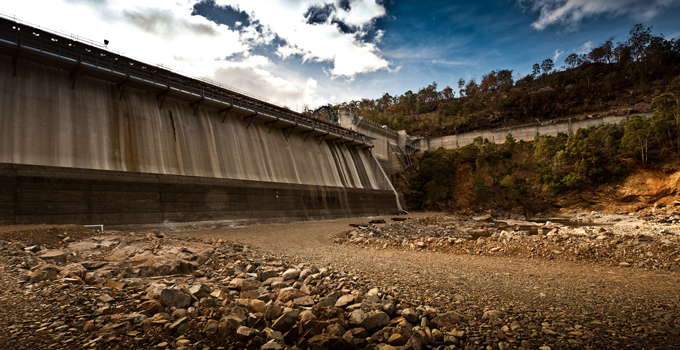
Around the world, businesses and communities face the many risks of climate change such as higher temperatures, changes in water availability and rainfall, more frequent and severe weather events. For power and water businesses, these may lead to major infrastructure damage and financial and environmental consequences.
In 2015 to 2016, these hypothetical risks became a challenging reality for Hydro Tasmania, Australia’s largest renewable energy producer and water manager. Hydro Tasmania faced unprecedented extreme weather conditions from September 2015 to June 2016 – and managed to come through the crisis while still safeguarding Tasmania’s ongoing access to high-quality, reliable water and power, and limiting environmental consequences and asset damage.
Entura supported Hydro Tasmania’s response to this major climate-related challenge through a range of earlier best-practice resilience-building measures, and significant interventions across a range of areas during the crisis itself.
What happened in 2015-2016?
Although Hydro Tasmania had experienced some variability in the past in Tasmania’s climate patterns, and despite understanding the risk of increasing future climate variability, the extreme dry conditions of September 2015 to April 2016 were unseasonal, unexpected and unprecedented. In Tasmania, summer inflows are traditionally low, but in this case, the usually dry summer was preceded by record-low spring inflows. Below-average rainfall across both spring and summer was the lowest recorded in 50 years.
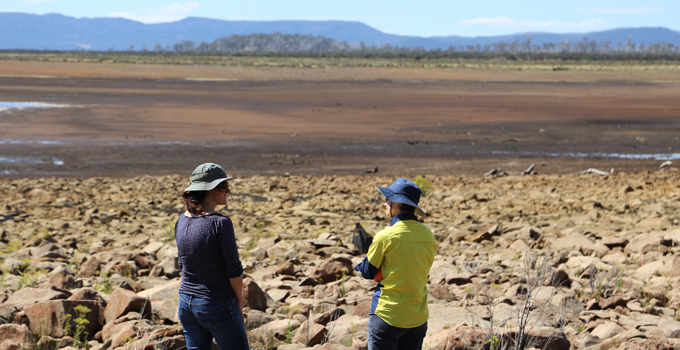
In normal operating conditions, low inflows could have been mitigated by importing power from mainland Australia across the undersea interconnector cable, Basslink, so that storages could be maintained. Yet, in another unprecedented scenario, in December 2015 the Basslink interconnector became inoperable just as summer arrived. Hydro Tasmania was now no longer connected to Australia’s national electricity market and many months remained before expected autumn/winter rains.
By late April 2016, Hydro Tasmania was experiencing its lowest storage levels ever, down to 12.5% total energy in storage, and serious environmental risks were emerging in some of its sites.
To compound the challenges, in January and February 2016 at least 70 separate fires were listed in Tasmania’s north-west, west, south-west and central highlands.
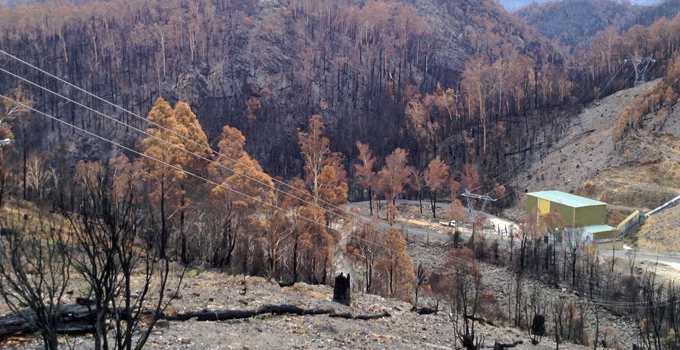
These extraordinary circumstances combined to present Hydro Tasmania with a major operational challenge. How could it keep the lights on and keep businesses operating in Tasmania while also protecting the environmental values associated with water storages and preserving the condition of its assets?
When the drought broke, conditions shifted from one extreme to another. Floods in June 2016 in northern Tasmania hit historic highs, exceeding all previous flood records in many locations. Several river-level measurement stations experienced the highest water levels on record.
How was the crisis managed?
Hydro Tasmania’s climate resilience and risk management strategies were called into action. Entura actively supported Hydro Tasmania through the energy supply challenge across a range of measures.
Generation planning and supply
To maintain adequate power supply, Hydro Tasmania drew on generation modelling and planning based on rainfall forecasts, climate model outlooks, and known and predicted electricity demand.
Voluntary reductions in major industrial loads were negotiated, and actions were taken to assess and instigate alternative generation options, such as restoring gas generation and implementing 200 MW of temporary diesel generation to bolster power generation. Entura assisted Hydro Tasmania to identify and assess feasible generation options and sites, and to progress these options through approvals and into operation.
Through these integrated and rapidly executed measures, Hydro Tasmania was able to maintain electricity supply for Tasmania without any outages for domestic users.
Environmental management and multiple water use
Another critical aspect of the successful result drew on Entura’s expertise in environmental management. Environmental impacts were monitored throughout the crisis. Lake-level risk bands were reassessed to better protect water quality and threatened species and to limit the long-term impacts on environmental values.
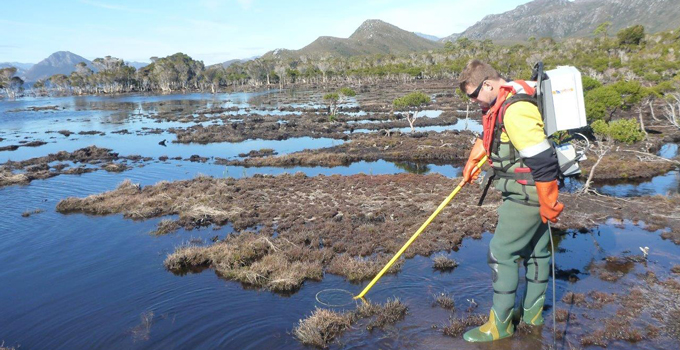
Water management also considered and mitigated impacts on other water users, such as boating, recreational fishing and water supply.
Bushfire management
The bushfires experienced across the state during the summer period did not adversely affect Tasmania’s energy security, as Bushfire Preparedness Fire Management Plans were already in place, and were activated to protect individual power stations and key assets through fuel reduction and other measures.
Dam safety and monitoring
Despite the extreme flood conditions, dams and spillways operated well within their design parameters, indicating that Hydro Tasmania’s ongoing dam monitoring and dam safety systems were robust. Safety inspections after the floods found only minor damage to non-critical elements of some dams.
During the high rainfall conditions, monitoring of dams and waterways provided alerts to downstream communities.
Road and asset management
Another consequence of the flooding was damage to some of Hydro Tasmania’s secondary assets (roads, canals) due to landslips, and the loss of some river-flow monitoring sites. Entura assisted with assessment and rectification of this damage.
Success drew on prior climate-resilience preparation
Ultimately, the example of Hydro Tasmania demonstrates climate resilience in practice. It shows how an investment in climate resilience enables a power and water business to be better prepared, more flexible and more robust in the face of a climate ‘shock’.
Hydro Tasmania’s management of the crisis required a comprehensive understanding of Tasmania’s climate and catchments. Entura’s involvement in 2007 in developing a Climate Change Response Strategy had provided a basis for this understanding, and a crucial input into identifying the risks and opportunities stemming from climate change.

Further inputs for climate resilience came through the collaboration in 2008 to 2010 between Entura and the CSIRO (Australia’s national scientific research organisation) on the first fine-scale climate and river system modelling for Tasmania, through the Climate Futures for Tasmania and the Tasmania Sustainable Yields projects.
The results of that research were state-of-the-art regional climate modelling and hydrological models to project future catchment yields for Tasmania. The modelling indicated that under climate change Tasmania could expect gradual temperature rises, changes in rainfall patterns over coastal regions, reduced rainfall over central Tasmania, changes to run-off patterns, and changes to the frequency and severity of extreme weather events including increased rainfall intensity and floods.
This modelling was critical in enabling Hydro Tasmania to plan and balance generation and storage levels over a range of demand and inflow scenarios and to assess environmental impacts during the extended period of drought.
Another key aspect of managing the energy supply challenges through the drought involved setting up supplementary diesel generation. This drew on Entura’s expertise and extensive involvement in developing hybrid off-grid renewable energy systems.
Hydro Tasmania’s climate resilience also involved being prepared for the drought to break. Key contributions from Entura included flood forecasting and flood support systems, ongoing support of Hydro Tasmania’s dam safety and emergency planning programs, and prior involvement in upgrading dams and designing spillways to withstand predicted increases in the frequency and magnitude of floods.
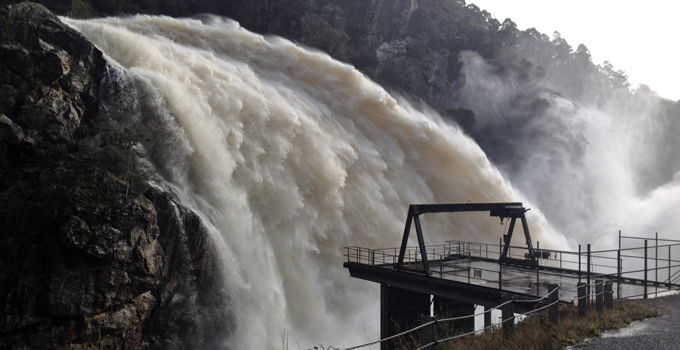
Entura also supported Hydro Tasmania’s procedures and ongoing activities to manage the secondary impacts of the fires and floods (such as damage to infrastructure), as well as the risks posed by low lake levels to social and environmental values. Entura’s environmental scientists monitored threats to aquatic flora and fauna through the 2015/16 crisis. To ensure the least likelihood of long-term or irreversible environmental damage, Hydro Tasmania’s environmental risk bands were revised.
Investing in your climate resilience
Any proactive and sustainable power or water business needs to invest in understanding the range, likelihood and consequences of the potential impacts of climate change for their current and planned systems and operations – whether for hydropower, transmission, dams, irrigation or water supply – and how to avoid or mitigate the impacts.
The more businesses understand the potential impacts of climate change and risks to their projects and operations, the better they can prepare, adapt, and build resilience to climate change impacts.
If you would like to learn more about building greater climate resilience into your project or operations, please contact Dr Eleni Taylor-Wood on +61 3 6245 4582, Phillip Ellerton on +61 439 010 172 or Shekhar Prince on +61 412 402 110.
About the authors
Tammy Chu is the Managing Director of Entura, one of the world’s most experienced specialist power and water consulting firms. She is responsible for Entura’s business strategy, performance and services to clients, and is part of Hydro Tasmania’s Leadership Group. As a civil engineer, Tammy specialised in the design and construction of mini-hydro and hydropower systems, project management, hydropower investigations, prefeasibility and feasibility studies, environmental assessments and approvals, resource investigations and resource water management. Tammy is a member of the Board of the International Hydropower Association. She was the first female and now past president of the Tasmanian Division of Engineers Australia, and was an Engineers Australia National Congress representative.
Dr Eleni Taylor-Wood is Entura’s Principal Consultant, Environmental and Social Science. Eleni has more than 20 years’ experience successfully managing large-scale, complex projects that run over several years, as well as providing expert advice and independent review for a range of infrastructure and planning projects. She has worked on projects around the world including in Australia, Mozambique, South Africa, Iceland, Colombia, India, Malaysia, Mekong, Solomon Islands, Fiji and Papua New Guinea. Her experience covers a vast gamut of studies including: environmental and social impact assessment and management; strategic management of wetlands and waterway; feasibility and approvals for new hydropower projects, environmental flow determination and assessment, and sustainability assessments. Eleni is currently one of eleven Accredited Assessors under the Hydropower Sustainability Assessment Protocol worldwide.
MORE THOUGHT LEADERSHIP ARTICLES
Overcoming the barriers to pumped storage hydropower
With energy reliability a hot topic in Australia, eyes are now turning to pumped storage hydropower… but what has been holding it back?

There are only three pumped storage hydropower projects in Australia, with the most recent completed more than thirty years ago. This is despite the ability of pumped storage hydropower projects to provide the large-scale storage that would complement increasing levels of renewable energy. Why is this, and what are the barriers to developing more Australian pumped storage hydropower projects?
Around the world, pumped storage hydropower projects make up the vast majority of grid energy storage and have traditionally been used by energy utilities to supply additional power to a grid during times of highest demand.
As part of a portfolio of power stations, a utility might operate a pumped storage project infrequently only, if the cost of pumping the water back to the upper storage exceeds the revenue that can be generated from its release.
The main issue facing developers trying to prove the viability of a new pumped storage project is that a sufficient price differential is required to pay for the pumping and to account for the efficiency losses in transmission, pumping and generation. The generation price needs to be sufficiently higher than the pumping price just to repay the variable pumping costs. To repay the heavy capital investment, a margin is required over and above the break-even cost of pumping. This is particularly true where proposed developments are ‘stand-alone’ and cannot be optimised as part of a corporate generation portfolio.
In recent years, electricity price spikes have been irregular with few occurrences each year. Due to the significant capital costs, a pumped storage scheme would require a certain number of pumping/generation cycles at high or maximum pricing to pay a return on investment. These price spikes are unpredictable, so building a business case around these events is risky.
Historically, the daily fluctuation of power prices has not been sufficient or regular enough to attract pumped storage developers. This is beginning to change with increasing penetration of renewable energy leading to an increase in both low and high price periods. More frequent, sustained periods of hot weather (as predicted by climate change models) will also drive up demand for power and therefore the market price.
In the last few months, volatility has greatly increased, creating a greater differential between baseload and peak pricing. This will increase the viability of pumped storage schemes, although the unpredictability and challenges of financing capital intensive assets will remain.
But, even when the economics are right, there are still some other barriers that proponents of pumped storage projects need to overcome:
Finding the right site
Pumped storage projects require significant capital for development. Minimising the cost of construction and operation is key to the successful development of a project. Choosing the right location is a matter of identifying a site with ideal topography, a source of water and good proximity to and location within the transmission network.
A wealth of information is available that is relevant to identifying potential pumped storage hydropower sites. Concept studies for pumped storage hydropower sites can screen potential sites quickly and offer developers greater insight into possible opportunities.
Negotiating access to appropriate sites for pumped storage
While a pumped storage project generally has a significantly smaller footprint than a traditional hydropower project, the features of natural topography that are ideal for pumped storage – high, steep hillsides or cliffs – tend also to be places of great natural beauty and are often designated as reserves, are expensive private land, or have high environmental or social value.
State governments can assist here through streamlined planning and approvals processes for infrastructure developments. This can make sure that the challenges of developing sites do not become insurmountable for developers.
Perceived environmental impacts
Pumped storage projects can occupy many square kilometres and also require transmission lines to connect to the electricity market. Like traditional hydropower projects, pumped storage projects need to attend to environmental issues associated with the project. Environmental impacts for pumped storage projects are assessed in the same manner as for all infrastructure developments.
If the impacts of a project can be mitigated to the satisfaction of the relevant regulatory body and international Standards (such as the International Hydropower Association and International Finance Corporation), a pumped storage hydropower project should face no greater hurdle than any other infrastructure project in this respect.
A pumped storage project may also have to deal with the perception that it uses carbon-intensive thermal power to pump water during the pumping cycle. This may be true unless there is a surplus of renewable energy available, in which case the pumped storage project could be seen to be using this excess renewable energy for pumping. As renewable energy penetration grows, the opportunities for storing surplus renewable energy will increase.
An unfavourable regulatory framework
Inconsistent and uncertain policy positions of the major political parties at both federal and state levels reduce confidence in the energy industry, which deters investment. With debate raging over energy security, a bipartisan view on energy policy, which transcends party politics and the electoral cycle, is urgently needed.
Existing mechanisms are in place to support the renewable energy industry. The Renewable Energy Target (RET) promotes investment in renewable energy projects; however, pumped storage is specifically excluded from the RET where the energy used for pumping exceeds the energy generated. Current policy would have to be amended or complementary legislation enacted in order to reward large-scale storage for the service it provides.
Such changes could include market mechanisms for large-scale storage that could offer incentives for providing inertia and ancillary services from storage at times of peak demand as well as power. Another possible change could be to ensure that large-scale storage asset owners are not penalised under the RET for energy used in the pumping process. This would encourage the development of energy storage as a complement to the growth of renewable energy.
High cost of development activities
The long lead times and high development costs of pumped storage projects are major deterrents to developers. Projects generally take more than 4 to 5 years from the point of conception to ‘power on’, and require millions of dollars of capital for development and hundreds of millions for construction. In other words, when funding is first committed, it may not see a return for five years or more.
In an effort to overcome this barrier, the Australian Renewable Energy Agency (ARENA) has indicated it will allocate at least $20 million to finance the accelerated development of flexible capacity and large-scale storage projects. The Clean Energy Finance Corporation (CEFC) has also committed to provide successful ARENA funding recipients with the opportunity to secure long-term debt finance to support their projects.
With an increasing interest and emphasis on storage in a power system that is becoming increasingly unreliable (e.g. load shedding in South Australia and lack of reserve events in New South Wales), and with finance from ARENA and CEFC for large-scale storage, the barriers to pumped storage development are gradually diminishing. This action can’t come soon enough for residents suffering through blackouts on days over 40°C.
If you would like to discuss how Entura can help you overcome the barriers for a pumped storage hydropower project, please contact Patrick Pease, Nick West on +61 408 952 315, or Richard Herweynen on +61 3 6245 4130.
A version of this article has been previously published as an op-ed in the Adelaide Advertiser.
About the authors
Nick West is a civil engineer at Entura with 16 years of experience, primarily in hydraulics and hydropower. Nick’s skills range from the technical analysis of the layout of hydropower projects to the preparation of contractual project documents and computational hydraulic modelling. Nick was a key team member of the Kidston Pumped Storage Project Technical Feasibility Study and was involved throughout the development and construction of the Neusberg Hydroelectric Project in South Africa. Nick has successfully completed projects ranging from hydraulic design for small residential developments to the feasibility study of a cascade of four large hydroelectric projects in Malaysia.
Richard Herweynen is Entura’s Technical Director, Water. Richard has three decades of experience in dam and hydropower engineering, and has worked throughout the Indo-Pacific region on both dam and hydropower projects, covering all aspects including investigations, feasibility studies, detailed design, construction liaison, operation and maintenance and risk assessment for both new and existing projects. Richard has been part of a number of recent expert review panels for major water projects. He participated in the ANCOLD working group for concrete gravity dams and is the Chairman of the ICOLD technical committee on engineering activities in the planning process for water resources projects. Richard has won many engineering excellence and innovation awards (including Engineers Australia’s Professional Engineer of the Year 2012 – Tasmanian Division), and has published more than 30 technical papers on dam engineering.
MORE THOUGHT LEADERSHIP ARTICLES
Planning for solar success
Planning regimes for large-scale infrastructure are rarely simple. Investing time and energy in planning for project approvals makes it more likely that your solar project will succeed.
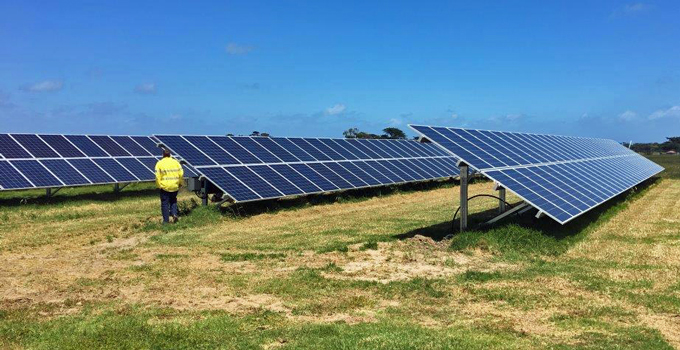
In this third part of our series of articles on overcoming potential roadblocks to solar developments, we take a closer look at how to navigate the planning environment for utility-scale solar PV energy projects.
Unlike domestic solar installations, which are often exempted from needing planning approval, larger utility-scale solar installations are likely to fall within the general planning requirements for renewable energy, which can significantly restrict the areas in which they can be considered.
The increased flexibility of the size and location of solar installations, and their ability to match the needs of users and supplement the capacity of the network, means that demand for solar is likely to rise in areas close to urban development. Solar installations servicing schools and universities, commercial development clusters or even specific neighbourhoods are set to become more attractive. The solar farm may become the new hobby farm.
However, due to the current constraints of planning systems in several Australian jurisdictions, renewable energy developments of this scale on many of these sites may be prohibited or dealt with inconsistently. Development control systems across Australia are generally not set up to facilitate development; rather, they control impacts. They are not proactive and lag behind the market, struggling to respond to rapidly emerging technologies and changing market demands. They can be frustrating to navigate and hard to change, which sometimes makes obtaining approvals hard work.
Is it easier to plan for a solar farm?
The planning system tends not to differentiate between various forms of renewable energy generation, constraining all forms due to the perception and experience of those forms with greater perceived impacts (such as wind farms).
Compared with wind farms, solar farms are less likely to encounter concerns about potential impacts on human health, visual amenity, birds and bats, or noise levels and have fewer physical constraints on location. Although solar developments are likely to have less visual impact than wind farms, this will still be an important issue to consider, as will glare and the area of ground coverage. High ground coverage means more potential impact on existing vegetation and less opportunity for complementary land uses.
While solar developments have more flexibility than some other forms of renewable generation to respond to, and avoid, local constraints, many of the important siting requirements are common to all renewable developments, such as the essentials of grid connection and construction access.
A particular consideration for large-scale solar developments is that large areas of flat land are often located in areas outside of council jurisdiction, which are state-owned and can be encumbered by existing leasing arrangements. More remote areas have greater potential to involve existing Native Title rights.
Solar developments have the potential to re-use degraded sites, such as mine sites which are no longer viable, and can complement the existing management and rehabilitation regime for these sites while also offering long-term energy solutions.
Navigating the planning requirements
The planning system is complex, and its potential impact on the cost, timeframe and overall success of your project should never be underestimated. Approvals for solar developments are not necessarily more complex than for other renewable energy developments, but some aspects will differ and the specifics of your particular project need to be taken into account.
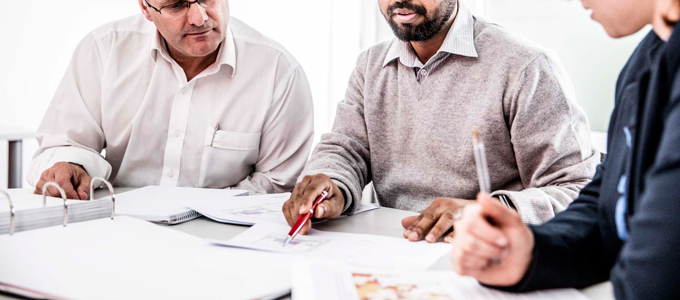
As with all large-scale infrastructure development, comprehensive regulatory mapping at an early feasibility level is essential to understand what approvals are likely to be required and where any dependencies exist. Critical approval paths, roadblocks, timeframes and likely information requirements can be estimated and guide stakeholder discussion.
Depending on the scale, location and potential impacts of the project, approvals may be required at the Commonwealth level (through the operation of the Environmental Protection and Biodiversity Conservation Act 1999), the state level (through the implementation of state environmental protection legislation), and the local level (through the implementation of a local development control plan or planning scheme).
Once the approval requirements are confirmed, detailed technical studies are essential for clearly demonstrating that the issues are understood and that the development (and any mitigation or management measures) is appropriate and effective.
The application documentation should be targeted to match and address the requirements of the relevant development control document drawing on the conclusion of the technical studies. It should include both a summary of the proposal that identifies the key issues and mitigation measures, and the detailed technical studies which underpin the planning assessment.
When permits are issued, it is usual for there to be a number of conditions requiring further actions or additional documentation to be submitted. Planning for these requirements is essential, as noncompliance can result in action by the responsible authority or, in some cases, lapsing of the permit.
Ultimately, your best chance of planning success is through fully exploring and understanding the development control provisions, permits, consents and the level of assessment that are required, obtaining high-quality and comprehensive specialist studies, and keeping a watchful eye on any project-specific hurdles.
If you would like to find out more about how Entura can help you overcome planning roadblocks for your solar development, contact Silke Schwartz on +61 407 886 872 or Patrick Pease.
MORE THOUGHT LEADERSHIP ARTICLES
Portfolio risk assessment takes dam safety programs to the next level
A portfolio risk assessment allows owners of dams and other water assets to see the bigger picture of how to prioritise their efforts and resources to achieve the best safety result across their whole portfolio.
Constraints on budgets and resources remain key challenges for owners of dams and water assets, especially those with a large asset portfolio, as they attempt to reduce the risk to communities to an ‘as-low-as-reasonably-practicable’ level. Without a tool to prioritise safety works, it is impossible to use limited resources most effectively.
Dam owners have often overlooked the importance of prioritising their dam safety activities, resulting in resources being allocated equally to all dams or allocated randomly to selected dams.
For example, the traditional indexing method, which uses a standards-based deterministic approach to review deficiencies at a dam, does not look at the consequences of those deficiencies, so it fails to inform the dam owner of the associated dam safety risk.
Using a method such as this can often lead to defensive design, cost-ineffectiveness, blind upgrade, or a generic surveillance and monitoring program across all dams, and does not greatly assist the dam owner in managing the dam safety risk. Ultimately, resources may be wasted on low-risk dams, rather than used appropriately on dams with high safety risks.
Current best practice involves a risk-based probabilistic approach and takes into account the risk of failure of each dam to prioritise dam safety works. However, for a large dam portfolio, a full detailed risk assessment for all dams can be very costly and time consuming.
So, how can an owner of a portfolio of dam assets assess safety and prioritise investment without unnecessary effort or expense? The answer is portfolio risk assessment.
How portfolio risk assessment works
A portfolio risk assessment (PRA) is often a starting point for an effective dam safety program. It is not a detailed risk assessment of any particular dam, but an affordable high-level assessment at the portfolio level that presents to the dam owner the relative risk position of all dams. This enables the dam owner to better prioritise ongoing dam safety works and develop investment strategies.
In a PRA, the safety risk posed by each dam in the portfolio is usually assessed based on historically available information as well as information gathered in a workshop-type environment by an expert team of various disciplines. Key failure modes of each dam are identified, and the risks are quantified based on available information.
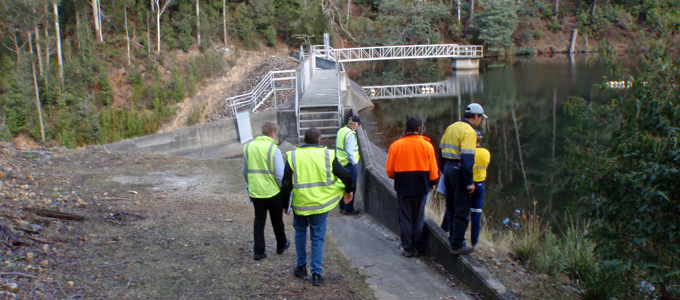
The key objective as a first step is to determine the first-pass risk position of the dams, followed by identifying any information gaps, strategy and priority to close these gaps. Output from a PRA can be tailored to suit organisational requirements, with risk positions determined in terms of societal, financial and political risks.
Flow-on benefits of the PRA process
PRA has proven to be a cost-effective tool in revolutionising an effective dam safety program for many dam owners in Australia and worldwide. It provides flow-on benefits to dam owners in managing their dam assets. In particular:
- Providing high-level focus and ease of reporting: A PRA provides an overview and high-level visibility and understanding of the current risk profile of the dam assets. This allows the dam owner to better focus on key dam safety issues, and makes reporting to senior management easier.
- Understanding relative risk and prioritising action: Establishing the risk profiles of all dams in a single risk plot not only informs whether the risk position of each dam is tolerable in accordance with industry best practice and guidelines, but also allows an understanding of the risk position of each dam relative to the others. This provides an opportunity for the high safety risk dams to be targeted first for dam safety activities, and allows prioritisation of dam safety recommendations.
- Best use of resources and identifying quick wins: Understanding the relevant dam safety risk profile provides clear direction for appropriately using resources to target mitigation of key risk items rather than attempting to implement all recommended actions at once, which is often not achievable. This also provides the opportunity to identify ‘quick win’ remedial works which may be less expensive yet significantly reduce risk.
- Ensuring key documentation is in place: Understanding the relevant safety risks of the dams also obliges the dam owner to ensure key documentation is in place, particularly for high safety risk dams. This may include dam safety emergency plans, operations and maintenance manuals, dam data books, hydraulic data, dam break inundation maps, and geotechnical reports.
- Reviewing surveillance and monitoring practices: A PRA provides an opportunity to review the existing dam surveillance and monitoring practice, and adopt a cost-effective risk-based approach to target the key failure modes rather than a blanket approach. As an example, a dam with a high risk of piping may require telemetered V-notches, whereas one without a high risk of piping may only require manually read V-notches or visual observations. In addition, the inspection frequency for dams with relatively low risk positions may be reduced, freeing up resources for use on dams with high safety risk.
- Improving dam safety emergency planning: An understanding of a dam’s key failure modes and failure consequences also allows improvement of critical dam safety information (e.g. event triggers, emergency evacuation), resulting in improved emergency planning.
Updating the PRA for continuous improvement
The outcome of a PRA would inform the knowledge gaps for any particular dams, and the necessary future works and investigations required to close those gaps. Following additional investigations, studies, remedial or upgrade works as a result of the initial PRA, it is good practice to update the PRA to review the portfolio risk and adjust the dam safety management strategy to achieve continuous improvement.
This will not only help dam owners to plan and prioritise their resources appropriately, but will also demonstrate to the regulator that an effective dam safety program is being implemented, which meets compliance requirements as well as industry best practices.
If you would like to discuss how Entura can assist you with assessing your dam risks through a portfolio risk assessment program, or apply the same PRA process to other key assets, please contact Shao Ng on +61 3 6245 4141 or Phillip Ellerton on +61 439 010 172.
About the authors
Shao Ng is a Senior Civil Engineer at Entura and has more than 16 years of experience in civil and dam engineering in Australia and overseas. Shao has considerable experience in project management, dam design and construction, geotechnical investigations, inspections and surveillance reviews, emergency planning, and dam operation and maintenance, and is familiar with national and international dam safety standards, guidelines and local regulatory requirements. Shao also has extensive experience in dam PRA.
MORE THOUGHT LEADERSHIP ARTICLES
Hydropower generates opportunities for businesses in India
In recent years, India has emerged as a world leader in renewable energy and this growth is presenting opportunities for businesses looking to diversify their activities.
A range of renewable energy developments such as wind and solar, from the smallest to the largest scale, are planned and getting underway all around India. There’s also still plenty of untapped potential for hydropower, particularly in the rugged north and north-west of the country.
Estimates suggest that less than a third of the country’s potential for hydropower has so far been exploited – and that presents an opportunity for organisations seeking to embrace renewable developments as part of their commitment to sustainable social and industrial development, quality of life, and a clean energy future for the nation.
The time is ripe for private investment in hydropower in India. Significant government incentives and subsidies are available to encourage increased hydropower development. Hydropower also offers added value to the power network in the form of immediately dispatchable power to balance any variability of solar and wind output.
Enthusiasm and opportunities are two important factors leading to hydropower success, but another critical factor is reliable expertise, and this may be less available to many potential proponents of hydropower projects if they are new to the hydropower sector.
Progressing through all the necessary steps of any power development process is difficult at the best of times, let alone for a developer who has little or no prior experience.
Hydropower, like all power developments, has its challenges: land acquisition, resettlement, rehabilitation, geology, technical challenges in dam and scheme design and construction, financing, and so on. These challenges can be considerable, but can also be overcome with the right expertise on hand.
Chanju-I hydropower project: a success story
When Indo Arya, a large conglomerate with interests in steel, thermal power and logistics, decided to make its first foray into hydropower, it recognised the need to engage an experienced hydropower consultant and it turned to Entura to provide the long-term support to ensure the hydropower project’s success, from the earliest feasibility study right through to operation.
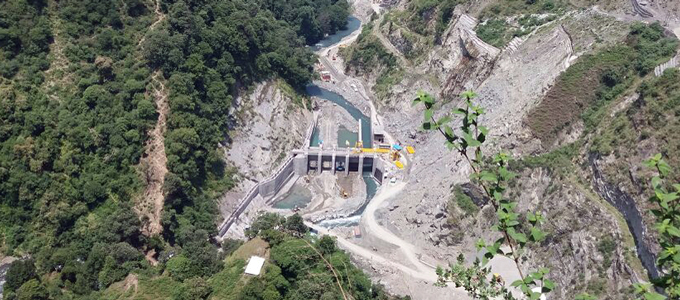
I A Energy, a special purpose vehicle, was formed for implementation of the Chanju-I run-of-river hydropower project in the Indian province of Himachal Pradesh. I A Energy provided all the financial and management capabilities, while Entura provided the technical expertise and project development knowledge.
Entura’s ongoing role in this project, supporting the client across all project stages as a trusted advisor, went beyond what might be described as ‘owner’s engineer’, achieving a considerable level of collaboration between developer and consultant that enabled the project’s success.
Now, nine years since the earliest site visits, the Chanju-I run-of-river hydropower project is set to deliver its 36 MW of renewable electricity, thanks to the power of the water flowing downstream from the confluence of the Bhararu and Chanju rivers. The project will generate attractive financial returns for its owner and the State Government, but will also directly benefit the local community, with power, tuition and health services.

Entura’s involvement over the full cycle of the project helped I A Energy ensure the right location, access and water availability for a viable project. We recommended the site, and then worked closely with the client to progress the project through its various stages, including site investigations, exploration of hydropower potential, environmental impact assessment, feasibility assessment, project approval, tender design, detailed design and construction advice and support.
Entura also assisted I A Energy to set up the organisation of the project and quality procedures on site, and our engineers regularly attended the site to provide ongoing advice and support during construction.
The project involved constructing a 16m-high barrage, a 5km-long headrace tunnel, two underground desilting chambers, pressure shafts, and a surface powerhouse. Entura provided technical expertise in optimising the design and construction, costing, contract packaging, selection of equipment, scheduling and project management. Our involvement delivered valuable outcomes such as increasing the asset capacity from 25 MW to 36 MW.
Overcoming project challenges
During the development phase, the Chanju-I project faced many issues and challenges with the potential to stop or significantly delay the project. These issues included approval delays, environmental issues, stakeholder management, and disagreements with upstream developers with respect to the location and height of the barrage, river basin development plans and infrastructural development.
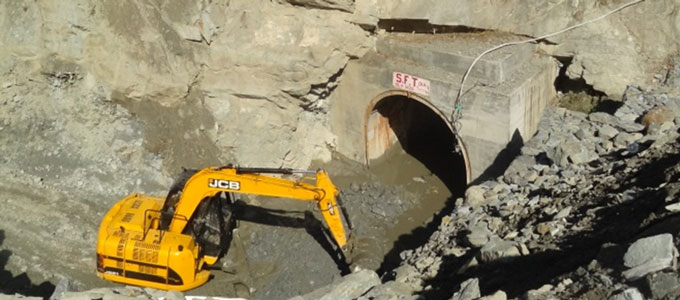
Entura’s continuous involvement, timely advice and support during critical situations helped the project team stay on top of these challenges, ensuring ultimate project success. In spite of the hurdles, the collaborative approach provided an efficient mechanism to address the issues and move the project forward at all times, even enabling early commencement of construction. By fast-tracking the construction of the project, the developer maximised its returns, and the project has been noted for its speed and efficiency in construction.
The way Entura serviced the project was praised by the project authority and strengthened our relationship with I A Energy. The longevity of Entura’s engagement with I A Energy on the Chanju-I project demonstrates the importance we place on delivering well for our clients, whether the project is small or large, and our ability to work as a valued and reliable partner of the client throughout the full project lifecycle.
To find out more about making the most of the opportunities available in the global renewable energy sector, please contact Shekhar Prince on +61 412 402 110.
MORE THOUGHT LEADERSHIP ARTICLES
Getting hydropower right: The six key considerations for a successful project
So, you want to develop a hydropower project? Any hydropower development is a major undertaking, so you need to be sure you get it right.
In our increasingly electricity-dependent world, hydropower offers a cost-effective and environmentally sustainable, clean-energy solution with significant development opportunities in Asia and Africa particularly.
Solving the technical challenges to establish a reliable hydropower scheme may seem complex, but engineering issues are only one part of the equation and may even be relatively straightforward compared with some of the broader issues and risks affecting a project’s success or failure.
Hydropower developments are more likely to gain social and regulatory approval, adequate and secure finance, and be successful in the short and longer term, if you pay early and detailed attention to the following six key considerations.
1 – What is the resource and how might it change?
Properly investigating the long-term history and variability of an area’s water resource is essential to the success of any hydropower project. However, even in areas in which water availability may have been reasonably consistent in the past, climate change introduces a new level of uncertainty for future projections.
To maximise the success of a new hydropower development for the short term as well as long into the future, it is essential to build climate resilience into projects. This requires specialist hydrological modelling based on the best historical data combined with expert future projections, taking into account the range of potential impacts on climate, rainfall, inflows and water availability.
Climate effects may not always mean reduced water availability. In some cases, the hydropower scheme may need to be able to accommodate and optimise the use of increased rainfall or inflow.
However uncertain the future resource, thorough investigation of what is currently known and what can reasonably be projected gives you the best chance of a successful, climate-proof scheme that can withstand future inflow variability and other longer term changes in the catchment.
2 – How stable is the proposed location?
One of the greatest potential complications and causes of delay in a hydropower development project is an unwelcome geological surprise.
Thorough, specialised investigation of the proposed site’s topology, geology and seismic risk is crucial, and can greatly impact cost, financing and viability. The more stringent and detailed the preliminary geological and geotechnical investigations, the more likely you are to avoid problems through the construction period and deterioration of the infrastructure over time.
This is particularly important where a large dam is proposed, as the extra weight of the water, concrete and sedimentation creates massive forces on the dam’s foundation, which may cover a large area and a potentially geologically diverse set of subsurface conditions. The choice of the appropriate dam type and construction method must be influenced by the unique conditions of the dam site, and stability of the site is a key consideration.
3 – How much power do you need now and will that change?
Populations and their demands for power don’t stay static for long. It’s important to think about the broader demographic of the region in which your scheme is to be developed. Is the population growing rapidly due to an ongoing rising birthrate, or could it shift significantly due to changes in neighbouring regions creating population movement?
Furthermore, industrial demand needs to be carefully projected, especially in a growing economy. What is the future development potential of local towns or cities? Is there potential for any major new industry in the region that may rapidly increase the power demand? On the other hand, are there any foreseeable threats to existing major industries that may suddenly lower demand?
As technology and lifestyle expectations change, especially in developing nations, residential demand may also rise rapidly. This demand can also be significantly, although usually predictably, variable, such as where climate extremes create peak demand coinciding with heating or air-conditioning requirements.
Another important factor, particularly in Asia and parts of Africa, is the potential for power generated in one country to be sold to neighbouring countries.
4 – Can you get the power to where it is needed?
A power source is only useful when it can reach a potential user. So another key consideration for a successful hydropower development is the ability to deliver the power to where it is needed through existing, upgraded or new transmission and distribution infrastructure.
Commonly, the best economic outcome of a power development is when much of the load can be used near to where it is generated, as this lowers the costs of transmission development, and lessens the loss of power when it is transferred over distance. Those few percentage points of power loss over distance could make the difference in the overall financial return on investment.
Careful planning of the routes for transmission and distribution lines is critical to success, with sizeable implications for project costs if lines must cross remote or rugged terrain, or socially or environmentally sensitive areas.
5 – What social and environmental impacts are possible?
From the earliest thoughts and discussions about a new hydropower development, it is critical to consider the project’s stakeholders, community and environment. As well as providing benefits to a project’s owner, electrification can deliver significant benefits to affected communities, raising living standards, alleviating poverty, helping to develop and diversify economic activities, as well as potentially improving water availability and management. However, hydropower should never be developed to the detriment of affected communities or the environment.
A ‘social licence to operate’ is fundamental to long-term success of your hydropower project. This can only be achieved where due consideration is given to social and environmental impacts throughout the project lifecycle, including those around changes in land use and ownership, and adequate consultation and engagement is undertaken with affected communities so that they receive a net benefit from the project.
Stakeholder engagement is the key to determining appropriate avoidance, mitigation, offsetting or compensation of any potential impacts – both immediate impacts, and impacts that may only emerge in the longer term. The most successful consultation is the ‘bottom-up’ and transparent approach, where affected communities are engaged and involved in the project right from its inception.
Safety is also a critical issue to be managed throughout a project’s life, including the safety of construction workers, ongoing employees, and the broader community. Identifying key safety risks early and managing them appropriately throughout design, construction and ongoing operation is critical to protecting a developer or owner against the major social and environmental consequences of a safety incident, as well as the long-term damage to that business’s reputation and financial viability.
6 – Can you obtain finance?
No hydropower project will succeed without available, secure project financing. Although hydropower developments offer opportunity to developers and financiers, lenders around the world are increasingly cautious and will require evidence of best-practice and sustainability to release project funds. They will need a range of risks to have been adequately investigated and mitigated, including all those considered above, as well as local political and regulatory issues.
A useful tool to evaluate the sustainability and strengths of a hydropower project and identify any further opportunities for risk mitigation is the Hydropower Sustainability Assessment Protocol.
Using a framework such as this offers investors greater confidence that their investment is safe, and that structured and systematic efforts have been undertaken to foresee risks across the spectrum of financial, technical, stakeholder, community and environmental issues.
Although not all risks can be avoided, this is the closest we can reasonably get to being confident that the project will not encounter any significant delays or problems through its lifecycle and will deliver the social, environmental and economic benefits it promises.
To discuss how Entura can help you plan and deliver a successful hydropower project, please contact Shekhar Prince on +61 412 402 110.
MORE THOUGHT LEADERSHIP ARTICLES
Keeping construction workers safe around high-voltage assets
Safety risks around high-voltage electrical assets are far from trivial, particularly those risks associated with earthing hazards during construction activities.
Keeping workers and contractors safe should be one of the highest business priorities. Safe systems of work and a strong safety record also ultimately benefit a business’s reputation, sustainability and long-term profitability. But achieving safety around high-voltage electrical assets means knowing your risks and how to control them, and one of these is the risk of an earthing-related hazard.
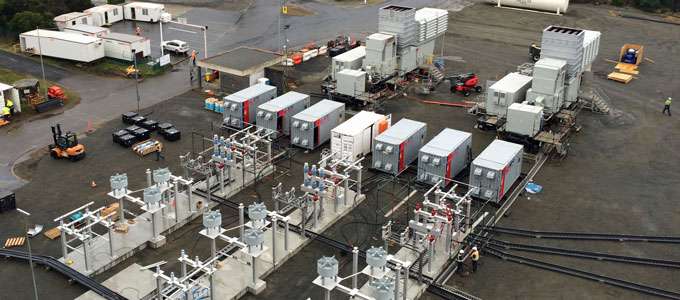
What is an earthing hazard, and how is it managed?
During a high-voltage electrical earth fault, such as a cable or equipment failure, electrical current passes from the faulted cable or equipment into the earth’s surface. One main function of an earthing system is to ensure the electrical protection system operates correctly (i.e. automatically turns the power off in a safe and controlled manner). As current passes into the ground, a localised voltage rise can be produced on the ground surface. Depending on a number of factors, this voltage rise can be harmful in the context of high-voltage installations.
As with any engineering design, the design and performance of an earth system is based on a set number of inputs. Some inputs are fixed; others are variable and may change over time. It is important for all owners of high-voltage assets to be aware of the variable components that their high-voltage earth system is designed to consider, and to ensure the safety of the system by taking corrective actions as deemed appropriate by standards and guidelines.
One such variable to consider is the safety of personnel and the public during construction activities, both within the site boundary and outside its footprint. According to Earthing Guideline 0 as referenced from Australian Standard AS 2067 (Draft 2014), the risk profile presented by the site will be affected by the increased presence of construction staff. This increased risk needs to be considered and addressed, and should result in site direction to construction staff.
Common earthing-related hazards
In general, leading contractors and asset owners pay a lot of attention to how earthing-related hazards and safety criteria may change when working in and around high-voltage assets. However, a range of common mistakes can be made during construction activities, which can introduce earthing-related hazards.
Typical mistakes include (but are not limited to):
- incorrect placement of temporary metallic security fencing or road barriers
- unnecessary removal or thinning of crushed rock layers
- exposure or breakage of subsurface earth systems
- incorrect placement of site sheds
- incorrect specification and arrangement of low-voltage electrical supplies for site sheds
- incorrect placement of equipment and infrastructure laydown areas
- incorrect planning of the work activities and procedures related to craning or elevated work platforms
- lack of site awareness regarding concealed and visible electrostatic and electromagnetic induction hazards.
What do you need to know?
High-voltage asset owners and construction contractors should ask these questions to ensure the safety of their construction personnel:
- Do I know where the high-voltage earth system is located?
- Does the work I am doing involve working inside or in close proximity to a high-voltage earth system?
- How far outside the earth system boundary do I need to consider the influence of the earth system? Is my work within this zone?
- Has this site’s earth system performance been assessed, and how recent was the last earth system audit? Based on the previous audit results, are the expected earthing-related hazard zones around the site clearly marked and controlled?
Although these questions may seem simple, without a high-voltage earthing layout drawing, a previous earthing audit report or intimate knowledge of the design criteria used to design the high-voltage earth system, you may not be able to answer the questions above with any certainty.
What are the right solutions to control defined hazards?
Solutions to possible causes of earthing-related construction hazards can vary from basic to complex. The most important thing is for the hazards to be properly assessed and managed in accordance with the risk management hierarchy of controls and the applicable national or international standards and guidelines.
In some cases, the traditional approach of earthing all metallic infrastructure may introduce hazardous voltages into the work zone rather than eliminating them.
How to build earthing safety into project planning
To ensure earthing safety during construction is not overlooked, asset owners should integrate a construction earthing assessment as a line item in their initial project schedules (during construction planning) and asset management plans. They should also provide constructors with an overview of typical construction activities that may present earthing hazards.
Because construction sites can change in layout, size and arrangement over time, it is important that a reassessment of possible introduced earthing-related hazards is also integrated into the construction plan, to ensure that earthing safety is maintained throughout the construction process.
The best results are achieved when the asset owner, the constructor and earthing specialists work together to develop appropriate project solutions to provide a safe working environment.
To discuss how Entura can help you assess your earthing safety risks, please contact Patrick Pease.
MORE THOUGHT LEADERSHIP ARTICLES
Managing risks for successful, sustainable projects
All power and water projects involve risks. The key to project success and sustainability is being able to anticipate, monitor and manage the full range of risks throughout the project lifecycle.
For power and water asset developers, sustainability is increasingly recognised as a key marker of project success and corporate reputation. Whether you’re building a hydropower station, a dam, a wind farm or a solar farm, achieving sustainability means ensuring that projects appropriately balance technical, environmental, social and economic considerations to deliver benefits and minimise risks across all these areas.
Power projects, especially in developing countries, hold great potential to contribute to the greater good by increasing prosperity and alleviating poverty, but growth must be balanced against any current and future impacts on communities or the environment. Sustainability is therefore a key concern for responsible developers, and for international financing organisations such as the Asian Development Bank, the International Finance Corporation and the World Bank.
Managing risks carefully, ethically and transparently can improve the financial and technical viability of the project, the ability to secure finance, the ability of key stakeholders to make informed decisions about the project’s future, the likelihood of community acceptance or ‘social licence to operate’, and the overall project outcomes, both now and for long-term success and sustainability.
What are the risks?
Some of the key risks to be considered throughout the design, development and operation of a power or water asset include factors such as the need or market for the project, the future energy or water demand, the best technology or design for the project, and the current and future availability of the resource.
It is also critical to consider the project’s stakeholders and broader community, particularly whether the project could involve potential social or environmental impacts and how these could be avoided, mitigated, offset or compensated, not just during development of the project but also during operation. Safety is also a key issue to be managed throughout a project’s life, including that of employees as well as the broader community.
Although not all risks will necessarily be able to be fully predicted, businesses are likely to gain substantial benefits from making structured and systematic efforts to foresee risks across the spectrum of financial, technical, stakeholder, community and environmental issues.
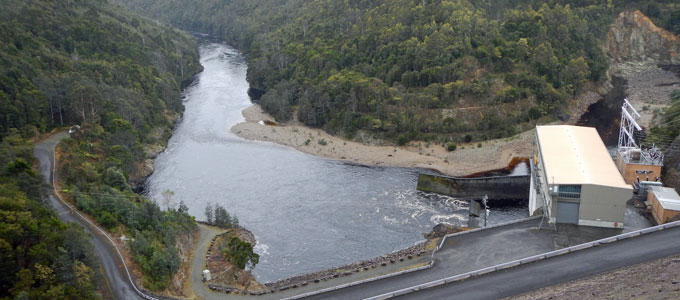
Assess risks early and often
Many project risks can be minimised or mitigated if they are properly anticipated early in the project, and progressively monitored and evaluated throughout the design, development, construction and operational phases.
Identifying key risks early allows companies to manage these risks throughout the project, minimising corporate, technical, environmental and social impacts and their associated costs, including damage to corporate reputation should an unmanaged risk develop into a crisis.
Assessing the risks progressively or in stages can minimise not only the cost of formal evaluation, but also save significant time and costs that could be wasted if a project were to be judged unviable during development.
Sustainability assessment, both formal and informal
Being able to formally or informally assess and comprehensively document risks and actions towards project sustainability offers significant advantages. While it can help guide a comprehensive review of risks, it can also help to identify further opportunities to increase positive outcomes. As well, it provides an easy way to regularly assess progress towards sustainability goals against established baselines, and offers a format for clear reporting both internally and to external funding bodies and stakeholders. In other words, sustainability assessment and reporting is a valuable step in demonstrating a genuine commitment and responsible approach to achieving greater sustainability.
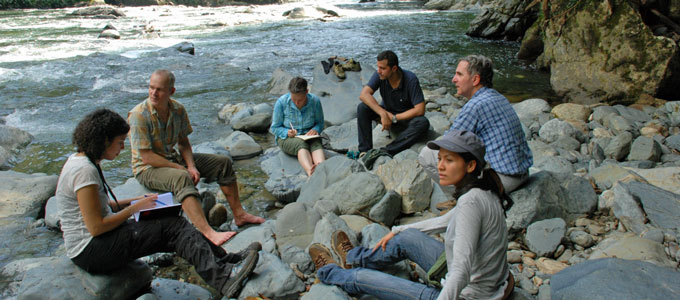
Entura uses a unique, tailored self-assessment tool to help power and water companies and developers understand the risks and opportunities facing their projects and build their capacity to assess, monitor and report on those projects. This tool is based on the assessment criteria identified in internationally recognised guidelines and standards such as the Hydropower Sustainability Assessment Protocol and those used by the International Finance Corporation.
The sustainability scanning tool can be used by an organisation to self-assess a project to identify whether key issues, risks and opportunities have been fully considered and to identify potential gaps needing further attention. This can be done internally following training on how to assess the criteria or undertaken by Entura’s trained assessors.
In addition, Entura’s sustainability scanning tool can be adapted to include other standards relevant to a project or client, or to assess compliance with criteria relevant to a client’s requirements or obligations (such as internal policies and/or permit or concession conditions). It can be used at any stage, or multiple stages, of a project, and for any level of sustainability goal (i.e. good practice or best practice). It can also be repeated over time for the same project to assess ongoing improvement, or to compare projects across a client’s portfolio.
The potential benefits to power and water asset developers of a systematic and thorough identification and management of the full range of project risks include easier access to finance, reduced corporate risks and costs, greater ability to anticipate and respond to stakeholder concerns, and avoidance of delays and problems through the project’s life.
This holds promise for delivering power and water infrastructure projects that are more likely to contribute positively to social, environmental and economic goals both now and into the future.
If you would like to discuss how Entura can assist you with assessing the sustainability of your project or support you to assess and track your own progress towards minimising risks and increasing sustainability, please contact Dr Eleni Taylor-Wood on +61 3 6245 4582 or Shekhar Prince on +61 412 402 110.
About the author
Dr Eleni Taylor-Wood is Entura’s Principal Consultant, Environmental and Social Science. Eleni has 20 years’ experience successfully managing large-scale, complex projects, as well as providing expert advice and independent review for a range of infrastructure and planning projects. She has worked on projects around the world including in Australia, Mozambique, South Africa, Iceland, Colombia, India, Malaysia, China, Solomon Islands, Fiji and Papua New Guinea. Her experience includes environmental and social impact assessment and management, strategic management of wetlands and waterways, feasibility and approvals for new hydropower projects, environmental flow determination and assessment, and sustainability assessments. Eleni is currently one of eleven accredited assessors worldwide under the Hydropower Sustainability Assessment Protocol.
MORE THOUGHT LEADERSHIP ARTICLES
Saving lives and protecting assets by reducing arc flash hazards
An arc flash is one of the greatest dangers electrical workers face, with potentially tragic consequences.
Each year, workers worldwide are killed or injured by arc flash – a type of electrical explosion (like a short circuit through the air) that can produce a deadly force equivalent to detonating a bomb.
As many as 10 arc flash incidents occur every day in the USA. In Australia, two electrical workers were killed in 2015 when an arc flash occurred in the power supply to a shopping centre. In mid-2015, another two Australian mining workers were seriously injured by an arc flash underground.
Being injured by an arc flash is, thankfully, not much more common in the developed world than being hit by lightning, but the injuries can be similar. Arc flash accidents can cause burns (often very severe, and most commonly to hands and face), injuries to the airways from toxic gases, damage to the eyes and ears from intense light and sound, and impacts from being thrown or being hit by flying objects or shrapnel.
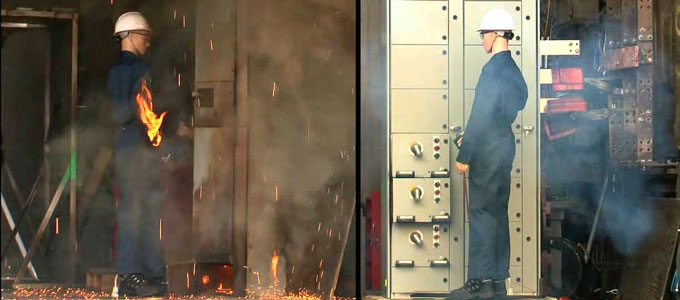
As well as the serious risks of injury or death that an arc flash hazard poses to the safety of workers and the public, it can also cause substantial physical damage to equipment and infrastructure, and prolonged outages or restricted power supply. And these impacts all add up to sizeable costs.
Including arc flash in the overall risk management strategy
To protect against the costly consequences of arc flash hazards, any owner or operator of electrical assets needs to incorporate the potential for arc flash events in their overall risk management strategy.
Wherever electricity supply is required, faults and arc flashes can occur, potentially at any time. This means that arc flash can never be completely eliminated in electrical transmission and distribution substations. However, there are known scenarios of greater risk, including times when the electrical system is under stress due to surges or faults; during maintenance; during switching or racking of the circuit breaker from the switchboard compartment; when asset condition is in decline; or when working with older types of switchgear, which typically have no arc fault containment features.
Calculating the level of risk
To understand the arc flash risk for a substation, calculations are performed to estimate the potential energy of an arc flash incident and to estimate the arc flash boundary (the distance from a live part from which a person could receive a second-degree burn). Fault clearing times are also calculated, as the time it takes to clear the fault is directly related to the energy of an arc flash. The fault clearing time depends on various factors such as the type of protection in place and the location of the fault, so a detailed analysis is required for individual sites to determine the arcing time.
Calculations are usually based on two North American standards, IEEE 1584 and NFPA 70E. Although neither of these standards applies fully to Australian workplaces, the combination of these two standards has become the de-facto local standard as no Australian standard currently exists. This lack of clear guidance means that every owner or operator of electrical assets needs to be confident that they are making the right risk management decisions by understanding current industry best practice.
Once these calculations have been made, the risk level of individual assets can be determined based on the likelihood of an arc flash (derived from factors such as asset condition and exposure of workers) and its consequence (derived from worker safety, equipment damage and loss of supply).
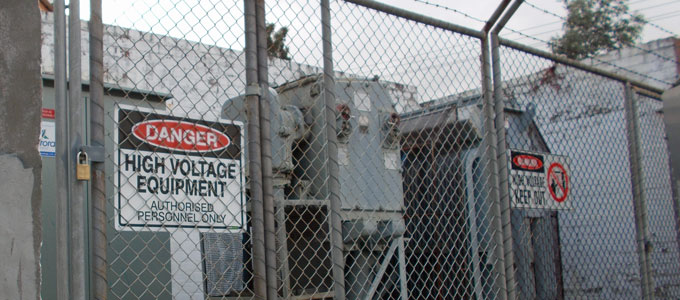
Lowering arc flash risk without breaking the bank
Our ultimate preference is to prevent an arc flash from occurring at all, but the inherent risks in an electrical asset may make full eradication difficult. Where the risk of arc flash is high, a combination of appropriate controls should be used to lower the risk to a more acceptable level.
Although personal protective equipment (such as an arc flash suit, or a face mask and gloves) is a necessary and relatively easy protective measure to implement, PPE will not protect a worker from impact-related injuries, nor protect equipment or reduce outages, so it is important to also fully investigate some of the higher rungs of the hazard reduction hierarchy of controls.
Other cost-effective control measures to mitigate arc flash hazards include increasing employee awareness and skills, reducing employee exposure, and reducing arc flash energy.
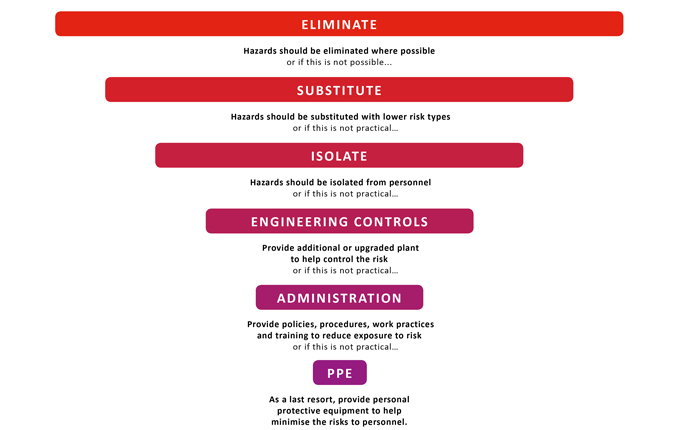
Given that arc flash incidents are most likely to occur when workers are present and are often caused by human error (such as dropped or mislaid tools or incorrect operation), it is important to make employees aware of the hazards and maintain employee skills through training and competence assessments.
Another easy way to improve worker safety is by limiting the exposure of workers by undertaking switching and racking remotely with no personnel near the switchgear.
A very effective engineering control to reduce the risk is by reducing the arcing time, which reduces the energy of the arc flash. This can be achieved by installing arc flash light-detection systems combined with fast-acting earthing switches. The light detection will pick up an arc flash very quickly (in around 4 milliseconds) and, by applying a three-phase connection to earth, the arc will be extinguished.
Keeping our own workers and assets safe
As part of Hydro Tasmania, Australia’s largest producer of renewable energy, Entura has been involved since 2012 in studying arc flash hazards on an extensive portfolio of electrical equipment to better understand its consequences. As asset owners, we appreciate the need to keep our workers and assets safe through achieving the best risk mitigation for the available investment of funds. We’ve brought this together with up-to-date knowledge of industry best practice and trends to assist clients develop safe and cost-effective strategies to confidently manage the risk of arc flash throughout their electrical asset portfolios.
To discuss how Entura can work with you to fully assess and address your electrical risks for greater worker safety and reduced outages, contact Patrick Pease.
MORE THOUGHT LEADERSHIP ARTICLES
Prioritising safety at Rouna 2 hydropower station, PNG
As the saying goes, ‘safety doesn’t happen by accident’.
The measures taken to address safety risks at the underground Rouna 2 hydropower station in Papua New Guinea offer a timely reminder of the basic requirements for adequately managing safety risks and protecting workers when upgrading older hydropower stations or when developing new ones.
The upgrade of Rouna 2 – including adequate exits, flood protection, fire and smoke detection and control, and emergency management – illustrates that much more than just the main generating equipment needs attention to adequately identify and address safety risks and hazards in a hydropower station.
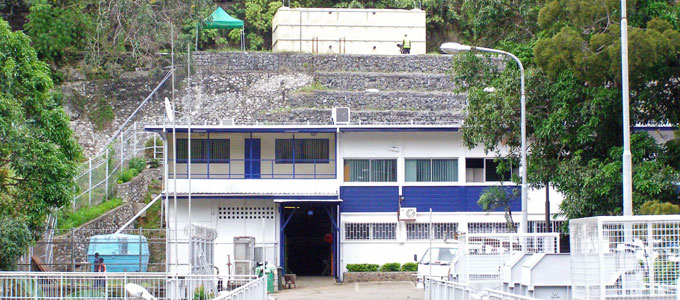
A run-down, risky hydropower station
Rouna 2 is one of four stations operating in a cascade down the Laloki River. It has five 6 MW vertical-axis hydro units from the late 1960s housed in an underground machine hall. Although only a small station, Rouna 2 has all the complexity and requirements of a much larger station.
By the time specialist power and water consulting firm Entura began working on the project to upgrade Rouna 2, the power station was old, run down by years of hard work, and was presenting its owners and workers with safety risks typical of many older hydropower stations.
The initial project concept was simply to refurbish the machines, but it quickly became clear that repairing or replacing only the generating units wasn’t going to be enough to sustain the power station’s operation, and that safety concerns needed to be urgently remedied.
Upgrading station evacuation
The Rouna 2 power station originally had only one access and exit route for the underground machine hall via open stairs in a 200 metre-deep vertical access shaft. No alternative emergency exit route was available. As the access shaft also contained all the power and control cables, it further intensified fire and safety risks.
To improve evacuation, a new emergency escape route was created via new ladders and platforms down the tailrace surge shaft to the tailrace tunnel, which normally carries water out of the power station.
Within the machine hall, the emergency escape route was made safer by being enclosed and made fire resistant, and kept smoke-free by a fan started automatically. Smoke hoods (emergency evacuation masks that reduce the risks of inhaling toxic smoke and gas) are provided to offer temporary protection for personnel needing to cover large distances to the start of the safe escape route.
To provide adequate lighting and signage for emergency escape, the DC-powered emergency lighting was upgraded. Evacuation alarms were improved, including strobe lights as well as audible sirens.
Improving flood protection
An underground power station surrounded by huge quantities of water under high pressure is particularly vulnerable to flooding. Rouna 2 had poor flood protection and dysfunctional evacuation alarm systems.
The evacuation alarms were upgraded and linked to flood detection within the machine hall. An automatic flood protection scheme was implemented to shut down the underground generating units and close the surface intake gate.
Improving fire and smoke detection and control
Hydropower stations are at risk of fire because they are full of electrical equipment. The Rouna 2 station had no fire detection system and minimal fire protection systems, so urgent attention to all fire measures was needed.
New fire panels and a new fire detection system were installed, as well as a new fire-fighting water supply, fire hydrants and hose reels. Sprinklers were installed in the access shaft and the machine hall. Older carbon-dioxide-based fire-protection systems for generator fires were replaced with water-spray systems. Fire doors were rehabilitated to close automatically.
Implementing an innovative new ventilation system
Ventilation systems in hydropower stations seldom provide any adequate smoke removal, despite the dangers of smoke inhalation. Technical innovations in the upgrade of Rouna 2’s safety systems included methods for smoke control integrated with the station’s ventilation system and its new fire panels and doors.
We upgraded the ventilation and smoke exhaust system by automatically reversing the ventilation fans during a fire, so that they exhaust smoke from the machine hall to the surface, and draw fresh air back down into the machine hall. At the same time, automatic fire doors close within the machine hall.
A safer power station for a safer future
Although new, large hydropower developments typically embrace complex and comprehensive safety standards and features, around the world many older stations are seriously deficient, presenting hazards that urgently need to be identified and resolved. Through our improvements to its ancillary services and safety systems, Rouna 2 is no longer in this extreme risk category.
However, adequate safety facilities are not the only requirement to maintain a safe hydropower station. Workers need the knowledge to maintain safety features, equipment and systems, and the skills to use them effectively. Entura has provided contract operators and station managers to work alongside local employees to help improve emergency and crisis management systems, provide local training and build capacity to ensure that Rouna 2’s future promotes a safer power station and safer workers.
To discuss how Entura can assist you with assessing hydropower station risks or developing a hydropower safety program or upgrade, please contact Shekhar Prince on +61 412 402 110.
This article was written by Ambrose Canning, Entura’s Principal Consultant, Mechanical Engineering (retired 2025).
MORE THOUGHT LEADERSHIP ARTICLES
Safer hydropower stations for safer workers
“Practices related to dam safety are well-defined and accepted throughout the world. However, hydropower safety encompasses more than just the dam … while hydropower safety is of critical importance, there is little shared knowledge on good practices around the concept of hydropower safety.” – International Hydropower Association
Hydropower stations can pose significant safety risks to those who work in them, but there is no excuse for injury or death in our workplaces. Whatever the history or location of the hydropower station, safe plant and safe work practices are critical.
Developers, owners and operators of hydro plant all need a strong commitment to workplace health and safety, and the insight and vigilance to control safety risks. As the saying goes, ‘safety doesn’t happen by accident’.
The hazards of hydropower stations
Some of the hazards at hydropower stations differ from those at thermal power stations or commercial installations. For example, hydro stations typically have limited access and no natural lighting, lower floors are often below the outside water level, and many are underground.
Hydropower hazards include fire, explosion (e.g. of pressure vessels), electrocution, flood, entanglement, slips and falls, chemicals (e.g. sulfur hexafluoride, hydrogen sulfide) and hazardous products (e.g. asbestos), and asphyxiation (e.g. carbon dioxide).
The level of risk presented by each hazard is a combination of its likelihood of occurring and the consequences if it did occur.
Seven ways to make a hydropower station a safer place
Designing safety into hydropower stations
When designing and implementing a new hydro scheme, or when upgrading an existing station, we need to carefully consider the standard of workplace health and safety to be achieved and the scope of work necessary to achieve it. This means understanding the relevant legislation, building codes and standards, and the requirements of the insurer; and being clear about the responsibilities of all the parties involved (such as the designer, developer, owner and contractors).
But while standards, codes and guides are a good starting point, the final solution needs to be tailored for the particular circumstances and level of risk. Safety systems for hydro plant can be complex and sophisticated, but they can also be as simple and robust as appropriate for the hydro facility being protected.
The primary consideration should be to provide safety facilities to get personnel out of a hydro station safely before conditions inside become dangerous. The second consideration should be providing facilities to get people out safely after conditions become dangerous. Only thirdly do we think about safety facilities to prevent damage to plant.
Planning ahead to control risks
A general approach taken to minimise workplace risks to the lowest practical level involves planning ahead for prevention of workplace accidents, injuries and illnesses, by ensuring that systems of work are safe, equipment is safe and properly maintained, and employees receive health and safety information and training and are properly supervised.
This approach is usually expressed through a ‘hierarchy of controls’:
Safety upgrades for older hydropower stations
Typically, new hydro stations are well designed and comply with appropriate safety standards and local building codes. Larger hydro stations can have safety systems as complex and thorough as those in modern multi-floor commercial buildings. However, older hydro installations were often designed with little regard to safety, and now need urgent attention to comply with modern workplace health and safety standards.
While safety facilities are readily incorporated into new hydropower schemes, they may be more difficult to retro-fit into existing schemes. The scope of work will need to take into account the interfaces with existing facilities and the tailoring required to suit the specific site and location.
Sharing our hydropower safety insights
Entura is part of Hydro Tasmania, Australia’s largest producer of renewable energy and manager of more than 30 hydropower stations with an enviable safety record. As a specialist power and water consulting firm, we’ve applied this real-world experience of designing safe hydropower stations and upgrading older plants to meet modern safety standards as we work with clients all over the world to improve the safety of their assets.
In our experience, these four very important aspects of hydropower safety should be considered as a first step towards building good practice for designing and operating safer hydropower stations:
| Station evacuation | Whatever the nature of the crisis, people must be able to get out of a hydropower station safely. All stations should have at least two independent ways to exit. If one route becomes inaccessible, an alternative emergency escape route should always be available. Adequate lighting is essential for emergency escapes. |
| Flood protection |
Hydropower stations can and do flood. Failure of drainage pumps can lead to a slow increase in the water level and eventual flooding of the station. Alternatively, a plant failure and leakage that drainage pumps cannot manage can cause rapid flooding of the station. This makes high-water-level alarms, flood alarms and evacuation alarms a necessity for life safety. Flood protection schemes can be implemented to automatically close intake gates or hilltop valves and keep turbines operating to attempt to drain the headworks and penstocks of water to control flooding, and to automatically stop hydro plant before the water levels become critical. |
| Fire and smoke control |
For life safety, we need to detect fires as early as possible, prevent them from spreading, alert all personnel, and provide safe and well-lit means of evacuation as soon as possible. Smoke control and ventilation are also extremely important. Fire will rapidly fill a hydro station with thick, black, acrid smoke, which is often a far greater hazard to personnel than the fire itself, as it obscures vision (preventing occupants from finding safe escape routes, as well as hindering search and rescue operations). It can also asphyxiate or poison people well before the temperature of the fire or smoke causes injury. A holistic fire protection system needs to attend to the full range of passive measures (e.g. fire-rated construction materials and methods), active measures (e.g. sprinklers, venting, fire-fighting equipment) and operational measures (e.g. plans, systems and training for fire prevention and response). |
| Emergency and crisis and management |
Safety at hydro stations involves more than simply having the correct equipment or hardware present at the site. It involves an ongoing commitment by the owner, management, operator and employees to provide and maintain a safe and healthy work environment. This commitment should be documented in writing and form part of a workplace health and safety policy supported by safe work systems and documentation. These should include a written risk control program and fire protection program, hazard register, site induction procedures, attendance boards, permit to work systems, local safety teams, and a detailed crisis and emergency plan. |
To discuss how Entura can assist you with assessing hydropower station risks or developing a hydropower safety program, please Shekhar Prince on +61 412 402 110.
This article was written by Ambrose Canning, Entura’s Principal Consultant, Mechanical Engineering (retired 2025).
MORE THOUGHT LEADERSHIP ARTICLES
Starting safe, staying safe: building safety into electrical design
Because electricity has inherent risks with serious consequences, safety should always be a fundamental concern of consultants and clients working with power assets at all stages of the project lifecycle.
We know that the safest and best outcomes are achieved by using a ‘safety in design’ process to ‘design safety in’ from the very start. As projects progress towards implementation, remedying risks becomes increasingly costly and progressively less effective, so it’s far better to get things right early on.

Safety applies to electrical design too
Giving greater and more systematic attention to eliminating safety hazards at the design stage emerged from the historically poor safety performance of the construction industry and is now well established.
Safety in design (SID) processes integrate hazard identification and risk assessment methods into the design of all aspects of a project to eliminate or minimise the risk of injury throughout the project or structure’s life (including decommissioning or disposal).
It is a common misconception that SID processes don’t apply to the electrical industry because we have ‘tried and true’ standardised designs that already comply with existing safe standards and systems, and are known to be safe.
While it is true that standard electrical designs are generally very safe during the operational phase of installations, the same cannot always be said about the construction, commissioning and decommissioning phases of an asset’s life.
Also, encouraging engineers to come up with innovative solutions often means modifying standardised designs. So the virtue of innovation carries the potential to create risks during the operational phase, if safety isn’t managed correctly.
A new set of skills
To effectively identify and manage safety risks during the construction, commissioning and decommissioning phases, the design engineer needs to have a new set of skills, not often included in the traditional education of a professional engineer. The engineer must understand not only how their design will function, but also understand the process of its manufacture, installation, commissioning, operation and decommissioning.
As part of Hydro Tasmania, Australia’s largest producer of renewable energy, Entura’s electrical engineers extend their skill sets and understanding of owning and operating assets by working through much of the same training as our asset managers and plant operators (including isolation, locking, tagging, low-voltage rescue and general power plant safety procedures).
Our close and long-term relationship with the extensive power assets of Hydro Tasmania also allows our specialists to spend much more time in operational power stations and switchyards than many other consultants.
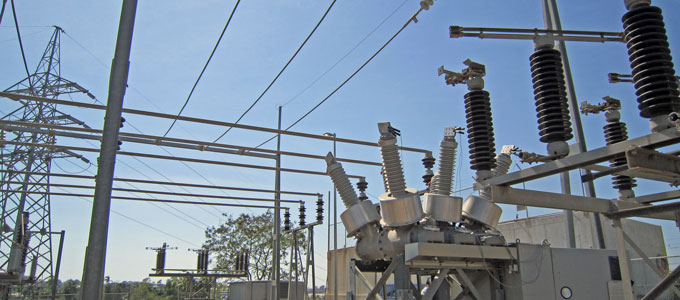
More than ‘ticking the box’
At Entura, we recognise that safety in design is not static, it can’t be done at just one point in time, it can’t just involve electrical designers, and it must be more than a ‘tick the box’ exercise if it is to make meaningful improvements to people’s safety as well as comply with regulations.
That’s why we integrate safety into the design process at all stages. Because design is not a simple or linear process, multiple safety review meetings allow the safety of the design to be formally reassessed at every step and for every phase of the asset’s life, in addition to the day-to-day awareness and integration of safety into all our design decisions.
Typically, at least two SID review meetings are held: one when the conceptual design is nearing completion, and one when the detailed design is 50–80% complete. The SID meeting for a complex project could include representatives from the client, the construction team, the design team and the plant operator.
Any limitations in the designer’s knowledge of the construction, operational or decommissioning environments are compensated for by the broader knowledge available at the SID review meeting. Further stakeholders who may have additional safety insights for specific or unusual issues can also be identified.
SID review meetings give engineers in different disciplines or specialties the opportunity to communicate and explain their decisions. Where a decision made by one engineer could inadvertently create a safety impact on another discipline, this can be quickly identified and appropriately remedied.
When the concept of SID is valued by engineers and clients, and appropriately built into project processes (whether for dam safety, hydropower station safety, or electrical safety), it results in safer designs. And safer designs make safer assets and safer workers. Investing early in designing out any foreseeable safety risks will save money and time through the project lifecycle, and will protect your reputation, now and into the future.
To discuss how Entura can help you ensure the safety of your electrical assets, contact David Wilkey on +61 407 875 391 or Patrick Pease.
About the author
David Wilkey is a specialist electrical engineer at Entura. David has 20 years of experience in a wide range of electrical engineering projects including power system studies, power system and generator protection, generator connection rules, and primary plant electrical engineering. David’s primary interests include all aspects of electrical engineering for hydropower projects, such as hydro turbine governors, generator excitation and generator protection systems.
MORE THOUGHT LEADERSHIP ARTICLES
Buying time: managing risks with flood forecasting
Almost every day, somewhere in the world, floods are putting lives at risk and causing major damage and financial impacts to buildings, critical infrastructure, agricultural land and crops, and the environment.
In 2013, almost 10 000 people were killed worldwide by flooding, and the lives of more than 32 million people were adversely affected by flood disasters. In Australia alone, the estimated cost of flooding is $400 million per year, and around the world the costs rise into the billions.
If you understand the specific risks and consequences of flooding in your location and area of operation, you can implement suitable emergency action plans to best manage these potentially catastrophic events, saving lives, reducing costs, and minimising impacts on property, infrastructure, communities and the environment.
Flood forecasting is a vital component of a total flood warning system. With increasing severity and frequency of extreme weather events likely in the future, effective flood forecasting systems are urgently needed to provide the accurate and timely warning of impending flood events that will improve public safety and minimise flood-related damage and costs.
Flood forecasting systems allow you to manage risk
Flood forecasting systems can be used by local authorities, water managers and owners of water assets to better manage a range of risks. By providing warning time of an impending flood, forecasting systems offer a window of opportunity for good decision making to reduce public safety risk through warning or evacuation, and to ensure informed management of water infrastructure.
Whenever a large volume of water is held or is transferred under pressure, potential risks to public safety and downstream infrastructure arise. The normal operations of water assets such as dams, pipelines and hydropower facilities regularly involve potential risks to the safety of both the general public and staff involved in construction, operation and maintenance. In this context, successful flood forecasting has obvious application, such as allowing operation of a dam to minimise flood peaks downstream, informing the timing or method of dam construction to avoid inundation of the works, or helping determine the need for emergency evacuation.
Sometimes flood risks can also be opportunities, if managed carefully. Flooding offers the gift of abundant flows to owners of hydropower assets or water supply or irrigation storage facilities. In this context, flood forecasting can provide strategic operational benefits to water managers by providing enough warning of impending large flows to allow optimal preparation for capturing, storing and using the plentiful water.
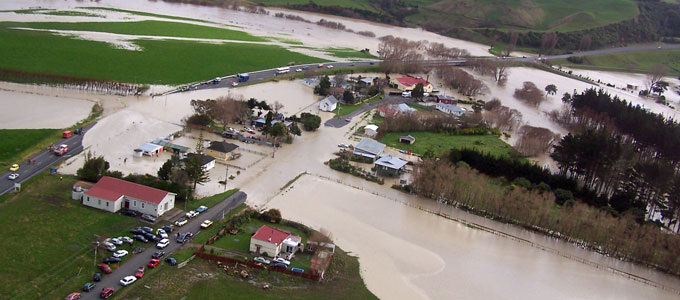
How are floods predicted?
Flood forecasting systems combine measured rainfall data and rainfall forecasts from weather forecasting agencies into a hydrologic model of a catchment. This model converts the rainfall into runoff and flow in rivers, or inflows to storages. These flow forecasts can be corrected with measured flow data in real time where this is available.
For some applications, these flows provide inputs to a hydrodynamic model of the river and surrounding area to give forecast flood levels and inundation areas.
The forecasts can then be displayed graphically or in another appropriate format for operators and water managers to use to manage flood risk.
The accuracy of flood forecasting depends on both the accuracy of the input data (rainfall, forecast rainfalls and flows) and the accuracy of the hydrologic modelling.
There is a necessary trade-off between forecast times and accuracy. The most accurate forecasts are based on measured flow data, but this gives very little warning time as the flows are already in the river. Forecasts based on conversion of measured rainfall to runoff using models give longer warning times but greater uncertainty. The longest warning times are achieved using forecast rainfall data, but these forecasts are the least certain.
Despite greater uncertainty, longer term forecasts can indicate that a water manager should keep watch for the possibility of a flood, and can offer more time to ensure that the correct procedures are in place to manage a potential flood risk, and to take actions such as optimum storage management to capture floods.
Best practice for successful flood forecasting systems
Successful real-time flood forecasting relies on capturing and storing accurate input data, reliable modelling, easily interpreted results, and timely alerts and warnings. Best-practice flood forecasting systems should include:
|
Accurate data capture from field sensors and available forecasts
|
Data collection sites for flow, rainfall and water-level information must be properly maintained, and any problems with sensors quickly addressed. Automated quality checking is needed to detect major data errors or missing data. There should be redundancy in the network, and routines within the modelling should allow for infilling with data from other sites if one site is out of service. Ideally, a range of possible rainfall forecasts would be included in the modelling to indicate uncertainty in forecast rainfall amounts. |
| Safe storage of all information in a robust database | Storing all data used in forecasting, and the forecasts themselves, allows analysis of the suitability of the input data for forecasting, and analysis of the accuracy of forecasts. Comparison of forecast and actual data can be used to adjust the models. |
| Optimal modelling and analysis to forecast flows and levels at key locations | Hydrologic and hydrodynamic modelling provide flows and water levels at critical points in the system, such as an inflow to a storage, the water level in a reservoir, the water level along a river, or an inundation area in a town. Models should be reviewed periodically with the most recent data to ensure that the parameters are still optimal and that the forecasts are performing as expected. |
| Automated forecasting run on a schedule | The forecasting system should be fully automated, with the ability to run more frequently in a flood situation if required. Where practical, the system should be fully redundant. A stand-alone system operable with manual data inputs can provide back-up if all communications to a site are lost. |
| Easily interpreted presentation of data and forecasts | Operators and managers need to be able to easily interpret forecasting outputs to make decisions. The visualisation of the data should be tailored for the individual user and include an indication of certainty. Displays may include maps of forecast inundation areas, forecast river levels and flows, or rainfall over a catchment. |
| Timely, automated warnings and alarms | Automated alarms and warnings alert water managers of any forecast floods that may exceed critical thresholds, providing time to ensure appropriate preparation and action. |
Applications of flood forecasting systems
Flood forecasting is a critical part of managing dam risk and public safety risks across a dam portfolio. As part of Hydro Tasmania, Australia’s largest water manager and renewable energy producer, specialist power and water consulting firm Entura provides real-time inflow and flood forecasting and data management solutions to help manage Hydro Tasmania’s own extensive catchments and a complex system including 55 major dams.
We’ve built on our experience in dam safety to offer flood forecasting expertise to a range of clients throughout the Asia-Pacific region for other important applications, such as providing the advanced flood warnings needed to protect assets and communities at risk, whether in regional areas or large metropolises.
To find out more about how Entura can partner with you to develop a tailored and complete solution to help you better manage your flood-related risks, contact Phillip Ellerton on +61 439 010 172 or Shekhar Prince on +61 412 402 110.
MORE THOUGHT LEADERSHIP ARTICLES
Climate resilience in practice
Climate change poses new uncertainties and risks to power and water asset developers, operators and financiers, in addition to the challenges already facing these sectors.
Higher temperatures, changes in water availability and rainfall, more frequent and severe weather events, and natural disasters may pose threats to power and water infrastructure as well as communities and the environment.
These risks are being increasingly recognised and acknowledged globally. But what practical steps can we take now to prepare our power and water assets and businesses for the impacts of climate change? Can we do more than ‘mitigate’ or ‘adapt’? Could innovative and timely action to manage risks strengthen businesses and increase their resilience to a changing climate?
The idea of building climate resilience recognises that climate change exists and will result in various forms of ‘shock’ to the systems in which we operate. Climate resilience is about taking action now to ensure that our business and economic systems and operations are well prepared for the types of disturbances that we may see more of in the future.
Climate resilience built into management strategies
Despite most businesses now recognising the realities of a changing climate, few have started to build climate resilience into their projects or operations. In a 2011 survey, 90 per cent of companies had faced climate-related impacts within the previous three years, but only 30 per cent were actively responding to those threats.
Although the possible future impacts of climate change are uncertain, including the financial implications for businesses, now is the time to invest in building resilience. Building climate resilience must become a standard component of overall risk management strategies, particularly for water and energy asset owners and operators.
The more we understand the potential impacts of climate change and risks to our projects and our operations, the better we can prepare, adapt, and build resilience to climate change impacts.
An owner–operator perspective
Hydro Tasmania, Australia’s largest renewable energy producer and water manager, has already experienced a level of climate variability, and is well aware of the implications of increasing variability in the future. This includes changes to average long-term system inflows, higher risk of major droughts, and occurrences of unseasonal and unprecedented weather conditions. Hydro Tasmania has been undertaking a range of activities that build its climate resilience.
As part of the Hydro Tasmania group, specialist power and water consultant firm Entura supports the business through a number of actions that safeguard Tasmania’s ongoing access to high-quality, reliable water and power.
Understanding vulnerability through climate change analysis
For Hydro Tasmania to address its vulnerabilities to future climate change, it first needed a more comprehensive understanding of how Tasmania’s climate and catchments may be affected in the future.
Entura collaborated with the CSIRO (Australia’s national scientific research organisation) to undertake the first fine-scale climate and river system modelling for Tasmania, through the Climate Futures for Tasmania and the Tasmania Sustainable Yields projects.
The results indicated that under climate change Tasmania could expect gradual temperature rises, increased rainfall over coastal regions, reduced rainfall over central Tasmania, changes to run-off patterns, and changes to the frequency and severity of extreme weather events including increased rainfall intensity and floods.
These conditions could have secondary impacts such as asset and building damage, sediment and debris accumulation, increased bushfire susceptibility, and environmental and social impacts.
Generation planning and drought management
With this improved understanding of future climate impacts, Entura is helping Hydro Tasmania identify and prioritise a range of actions. State-of-the-art hydrographic data and hydrological forecasting enables Hydro Tasmania to improve generation planning, management of storages, and drought management.
Generation can be planned over a range of time-scales and demand scenarios, supported by long-term storage targets and storage operating rules. Additional storage can be accessed to help drought-proof the system in low inflow periods. When lake levels are low, management procedures built into the storage operating rules minimise risks and impacts on social and environmental values.
Flood forecasting, dam safety and emergency planning
Being climate resilient also means preparing for ‘too much’ water. While higher rainfall can result in increased flooding, it can also be a gift to hydropower asset owners, if managed carefully.
Entura has helped Hydro Tasmania assess how to upgrade its power schemes to maximise the benefits of predicted water increases for increased power generation. We have developed flood forecasting and flood support systems, and supported Hydro Tasmania to make improvements to its dam safety and emergency planning programs.
And by being involved in upgrading dams and designing spillways to withstand predicted increases in the frequency and magnitude of floods, we’re contributing to building greater potential resilience into Hydro Tasmania’s assets and operations.
Managing assets for long-term sustainability
Climate resilience for long-term sustainability is a key consideration for a proactive, risk-based asset management program. Entura builds climate risk management and resilience into our projects right from the earliest stages of planning and throughout the design process.
We do this by fully considering and testing the range of operating scenarios and conditions that may be encountered, and building in robustness and flexibility to deal with the potential range of situations.
For example, we:
- explore ways to reduce the damage to turbines due to increased silt, sediment and debris caused by extreme rainfall
- consider solutions to the potential thermal gain in power stations in warmer conditions and its subsequent impacts on generator temperature and performance
- evaluate how transmission line design might address the predicted climate variability along the length of transmission line corridors, and whether the present standards are sufficient for potential future conditions, and
- consider the impacts of wind loading, changes in drainage and the efficiency of foundations.
Protecting environmental and social values
Entura is providing ongoing support to Hydro Tasmania to build climate resilience into its operations while also managing environmental and social values.
This includes accommodating multiple users of water resources through maintaining adequate downstream flows for the environment, water supply, irrigation and recreational uses, and protecting fisheries resources and threatened species.
Supporting global efforts to build climate resilience
Entura supports clients throughout Asia, the Pacific, and southern Africa to build their own climate resilience strategies and actions. We help our clients understand the risks and potential impacts of climate change for their current and planned systems and operations – whether for hydropower, transmission, dams, irrigation or water supply – and advise them on the likelihood and consequences of these risks and impacts occurring.
Through understanding the vulnerabilities of our clients’ businesses, we help develop operational solutions that will increase resilience to future changes in climate and improve long-term business viability.
If you would like to learn more about building greater climate resilience into your power or water project or operations, whether for hydropower, transmission systems, dams, irrigation or water supply, please contact Dr Eleni Taylor-Wood on +61 3 6245 4582 or Shekhar Prince on +61 412 402 110.
About the authors
Tammy Chu is the managing director of Entura, one of the world’s most experienced specialist power and water consulting firms. She has extensive managerial and business development experience in the consulting engineering industry within Australia and internationally, focusing on business strategy, change and transformation, international sales, culture, and profit and revenue growth. As a civil engineer, Tammy specialised in the design and construction of mini-hydro and hydropower systems, project management, hydropower investigations, prefeasibility and feasibility studies, environmental assessments and approvals, resource investigations and resource water management. An active member of the engineering community, Tammy publishes papers on a range of subjects, and regularly presents at conferences.
Dr Eleni Taylor-Wood is Entura’s Principal Consultant, Environmental and Social Science. Eleni has 20 years’ experience successfully managing large-scale, complex projects that run over several years, as well as providing expert advice and independent review for a range of infrastructure and planning projects. She has worked on projects around the world including in Australia, Mozambique, South Africa, Iceland, Colombia, India, Malaysia, Mekong, Solomon Islands, Fiji and Papua New Guinea. Her experience covers a vast gamut of studies including: environmental and social impact assessment and management; strategic management of wetlands and waterway; feasibility and approvals for new hydropower projects, environmental flow determination and assessment, and sustainability assessments. Eleni is currently one of eleven Accredited Assessors under the Hydropower Sustainability Assessment Protocol worldwide.
MORE THOUGHT LEADERSHIP ARTICLES
The hidden risks in hydropower projects
Hydropower is increasingly becoming a major source of renewable energy for emerging markets throughout Asia.
Managing the not-so-obvious risks associated with developing and operating hydropower schemes is often a key challenge in securing project finance and gaining or maintaining a social licence to operate.
“Power projects, especially in developing countries, are increasingly scrutinised by international financing organisations when providing project funding” said Dr Eleni Taylor-Wood, Principal Consultant, Environmental and Social Science at specialist power and water consulting firm Entura.
“These entities, such as the Asian Development Bank, the International Finance Corporation and the World Bank, recognise that growth must be both inclusive and environmentally sound to reduce poverty and build shared prosperity for today’s population and future generations.”
Managing risk across all stages of a project can improve the viability of a project and the overall project outcomes.
What are the risks?
It is critical that both governments and hydropower entities understand the opportunities and risks of major projects, not only at the development stage, but also throughout the ongoing operation and management of the scheme.
Typically, some of the key risks to be considered include:
- Is there an identified need, what is the future demand, and is there a market?
- What is the best energy option?
- Could any political or public sector issues affect the project?
- Is there the institutional capacity to advance the project?
- How available is the resource? Will climate change affect availability?
- Is the site appropriate? Are there other options?
- Can you connect into the grid, and where? What systems enhancements might be required?
- Who are the key stakeholders and how can they be engaged?
- What are the possible environmental and social impacts, and how can they be avoided, mitigated, offset or compensated?
- What safety issues are associated with development, construction and operation, and how can they be managed?
- What are the ongoing operational costs?
- What are the ongoing operational requirements, such as compliance requirements, condition assessments, performance monitoring, maintenance strategy and planning, and training to build operator skills?
- How will you manage unforeseen stakeholder, technical, financial, social and environmental issues?
Using international standards and sustainability assessment frameworks to manage risks
International standards and sustainability assessment frameworks can help guide a comprehensive review of risks and, in some cases, identify further opportunities to increase positive outcomes from projects.-
In 2010, the International Hydropower Association launched the Hydropower Sustainability Assessment Protocol, a framework for assessing the sustainability of hydropower projects across the world. This framework can be used to help guide a hydropower project from the early stages of consideration through to operation, identifying issues and gaps for consideration, as well as be used to assess the project’s sustainability performance.
There are only eleven accredited assessors able to officially apply the Protocol worldwide. Entura’s Dr Eleni Taylor-Wood and Dr Helen Locher are among this select group of accredited assessors, having undertaken assessments of hydropower projects in Europe, South Asia, South-east Asia and South America.
One step at a time
“Evaluating the risks in stages means that the cost of evaluation can be minimised should the project be judged unviable at any point. Not all risks can be avoided, but many can be minimised or mitigated,” explained Dr Taylor-Wood.
Early identification of key risks allows companies to manage these risks throughout a project, minimising corporate, technical, environmental and social impacts and their associated costs, including damage to corporate reputation should an unmanaged risk develop into a crisis.
Self-assessment and capacity building
“I believe that for hydropower developments to be sustainable, we need to use the lessons of the past to innovate in the present and protect the future,” said Dr Taylor-Wood.
“This means learning from mistakes and carefully assessing and managing technical, corporate, economic, environmental and social risks right across the project lifecycle, so that developments contribute positively to social, environmental and economic goals.”
Entura uses a unique, tailored self-assessment tool to assist power companies and developers to understand the risks and opportunities facing their projects and to build capacity to assess, monitor and report on those projects.
This tool is based on the assessment criteria identified in guidelines and standards such as the Hydropower Sustainability Assessment Protocol and those used by the International Finance Corporation.
In addition, it can be adapted to include other standards or to assess compliance with criteria relevant to a client’s requirements or obligations (such as internal policies and/or permit or concession conditions).
Benefits include easier access to finance, better ability to anticipate and respond to stakeholder concerns, and avoidance of delays and problems through the project development pipeline.
Entura provides expert advice to help clients:
- develop a better understanding of risk identification, assessment and sustainability, across all project stages
- self-assess a project against recognised guidelines and standards to identify whether key issues, risks and opportunities have been considered and identify potential gaps for further consideration
- meet international financing requirements
- assess viability or conduct a due diligence of a project
- undertake assessments against the Protocol
- address risk issues to improve the overall sustainability performance of projects
- build institutional capacity to develop, operate and/or maintain power schemes.
eleni.taylor-wood@entura.com.auIf you would like to discuss how we can assist you with assessing your project or how you can assess and track your own progress towards improved risk minimisation and sustainability, please contact Dr Eleni Taylor-Wood on +61 3 6245 4582 or Shekhar Prince on +61 412 402 110.
About the author
Dr Eleni Taylor-Wood is Entura’s Principal Consultant, Environmental and Social Science. Eleni has 20 years’ experience successfully managing large-scale, complex projects that run over several years, as well as providing expert advice and independent review for a range of infrastructure and planning projects. She has worked on projects around the world including in Australia, Mozambique, South Africa, Iceland, Colombia, India, Malaysia, Mekong, Solomon Islands, Fiji and Papua New Guinea. Her experience covers a vast gamut of studies including: environmental and social impact assessment and management; strategic management of wetlands and waterway; feasibility and approvals for new hydropower projects, environmental flow determination and assessment, and sustainability assessments. Eleni is currently one of eleven Accredited Assessors under the Hydropower Sustainability Assessment Protocol worldwide.
MORE THOUGHT LEADERSHIP ARTICLES
Reliable, renewable energy now powering South Africa
In many developing nations, governments and utilities are scrambling to bring much-needed power to their people and industries to improve quality of life and drive economic growth.
Small hydro (around 40 MW or under) from run-of-river schemes is an ideal solution to contribute to growing and greening the energy mix in developing countries, providing clean and reliable power from a country’s rivers without the significant environmental or social impacts of large dams or the economic and environmental costs of fossil fuels.
The Neusberg hydropower project – a run-of-river small hydropower project near Kakamas in the Northern Cape of South Africa – is one small but effective step towards South Africa’s ambitious goals of raising the living standards of its growing population and supporting vital economic activity through encouraging the development of renewable energy by independent power producers.
What is the Neusberg hydropower project?
Using the power of the mighty Orange River, the Neusberg hydropower project creates electricity by diverting some water for a short distance as it runs downstream from the existing Neusberg Weir, returning the water back to the river after it runs through the hydroelectric plant’s three 4010 kW turbines.
The Neusberg project is highly efficient, producing 10 MW of reliable and sustainable baseload power for the equivalent of up to 5000 homes with no adverse impacts on irrigation, fish or environmental flows.
Success through collaboration, innovation and expertise
The Neusberg project needed a particularly innovative design solution and effective planning and collaboration for it to meet the needs of the region, satisfy the requirements of all major authorities and stakeholders, and still achieve the objectives of the developer.
And that’s where specialist power and water consulting firm Entura drew on its extensive experience in hydropower development to find the right answers to move the project towards successful completion.
For example, developing all the necessary tender and contractual documentation and negotiating and achieving regulatory approvals are critical administrative steps but can prove challenging. Entura’s owner’s engineer services helped the Neusberg project overcome these development-stage hurdles – such as helping to achieve the vital water use licence by proposing suitable designs for the project and then working through a collaborative process to modify the designs to meet the authority’s requirements while still achieving the developer’s objectives.
Tailored solutions for tricky challenges
A major challenge for the Neusberg project was to produce economical and reliable power to relieve pressure on the electricity network at the same time as ensuring adequate water supply for irrigation by local fruit-growers throughout the construction and operation of the project. Other specific local requirements also needed to be met, such as maintaining the ability of the Neusberg Weir to meaningfully measure river flow, maintaining the aquatic environment and minimising the impacts from construction activities.
- To guarantee an uninterrupted supply of water to the local irrigation scheme, construction of the hydro project called for clever planning. Since an existing irrigation canal ran through the powerhouse site and needed to remain in operation, a temporary diversion canal was created to allow the powerhouse and forebay to be constructed in two stages without interrupting irrigation supply.
- To ensure that the flows into both the hydroelectric project and the irrigation canals are sufficient, a weir was placed at the offtake for the hydro project providing passive protection against the water level in the reservoir being drawn down. The level of the top of the weir was carefully designed so that the length of the weir was reduced – lowering construction costs while providing the protection required for the irrigation canal and allowing sufficient flow into the headrace canal.
- The Neusberg Weir is a very important flow measuring structure as it provides accurate information on the flow in the Orange River to both South Africa and Namibia. The hydro project takes water away from the weir, so to restore the ability to measure flows, two devices were installed – an instrument in the canal upstream of the powerhouse, and the weir in the tailrace. The measuring weir in the tailrace provided an extra benefit for the aquatic environment, by acting as a barrier to fish movement and enabling fish to find their way to the existing fish ladder to travel upstream.
- To minimise costs and impacts of construction, the design of the Neusberg project dispensed with the typical aboveground powerhouse structure. Instead, the concrete roof of the powerhouse has a removable hatch allowing equipment to be lowered through the roof by crane into the turbine chamber.
Community benefits both now and into the future
The Neusberg project has brought an ongoing social and economic boost to the local community that goes well beyond providing an important source of electricity. During the construction phase, it created much-needed local employment in a region in which opportunities are scarce, and supported local and national businesses through spending on goods and services.
But the benefits keep flowing long after construction is finished, as the local community has a
15 per cent ownership stake in the hydropower scheme and an 8 per cent stake in operation and maintenance contractors, ensuring that the community trust will share in the project’s success for many years to come.
Entura’s role in the Neusberg project
Entura has played a vital role in the successful civil design and was also responsible for the electrical and mechanical construction of the Neusberg project by drawing on our day-to-day experience of owning, operating and maintaining hydropower assets for more than 100 years as part of Hydro Tasmania, Australia’s largest renewable energy producer and water manager, and an equity stakeholder in the Neusberg project.
If you would like to discuss how Entura can help you develop a hydropower scheme that can meet your power needs in a cost-effective and sustainable way, please contact Christoff LeGrange on +27 21 202 2231 or Shekhar Prince on +61 412 402 110.

